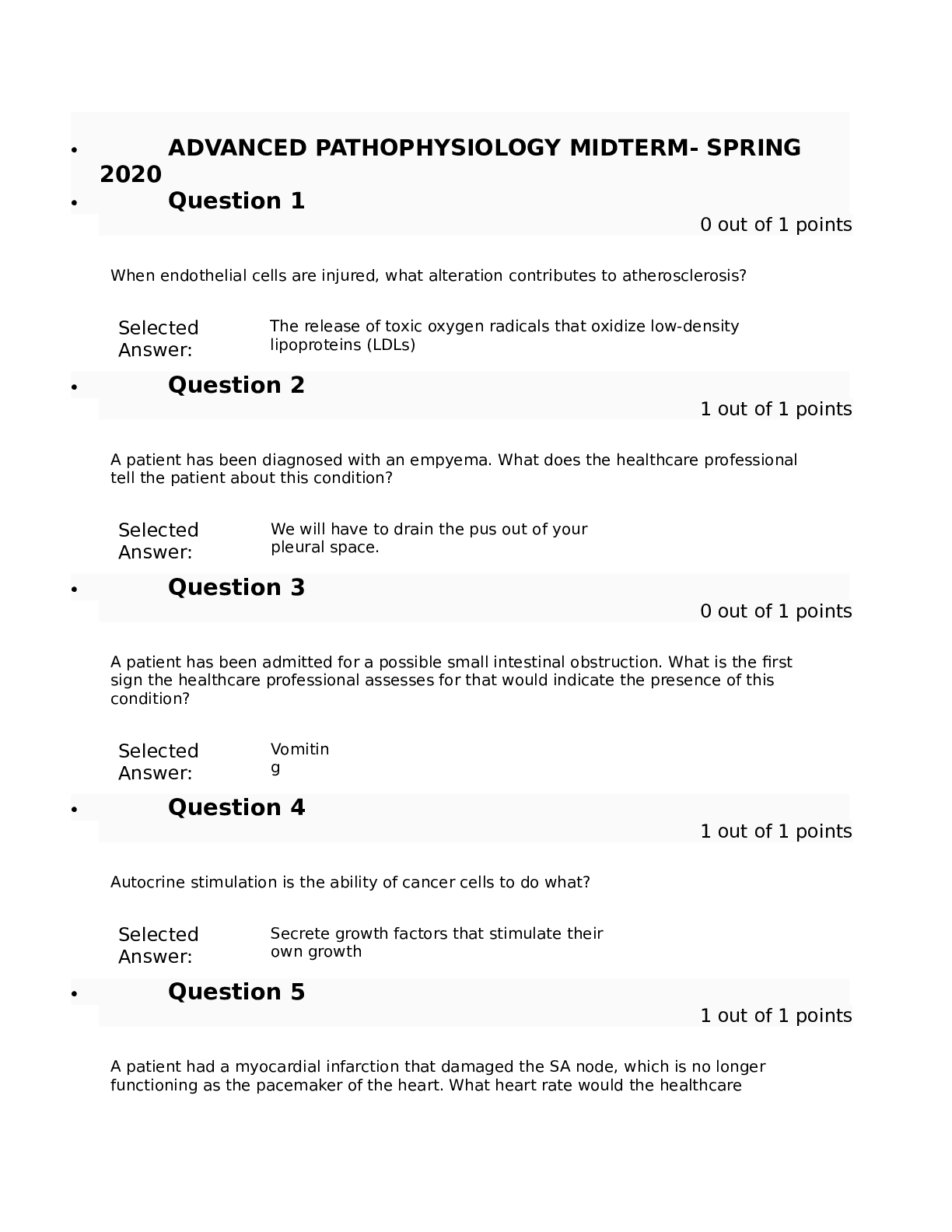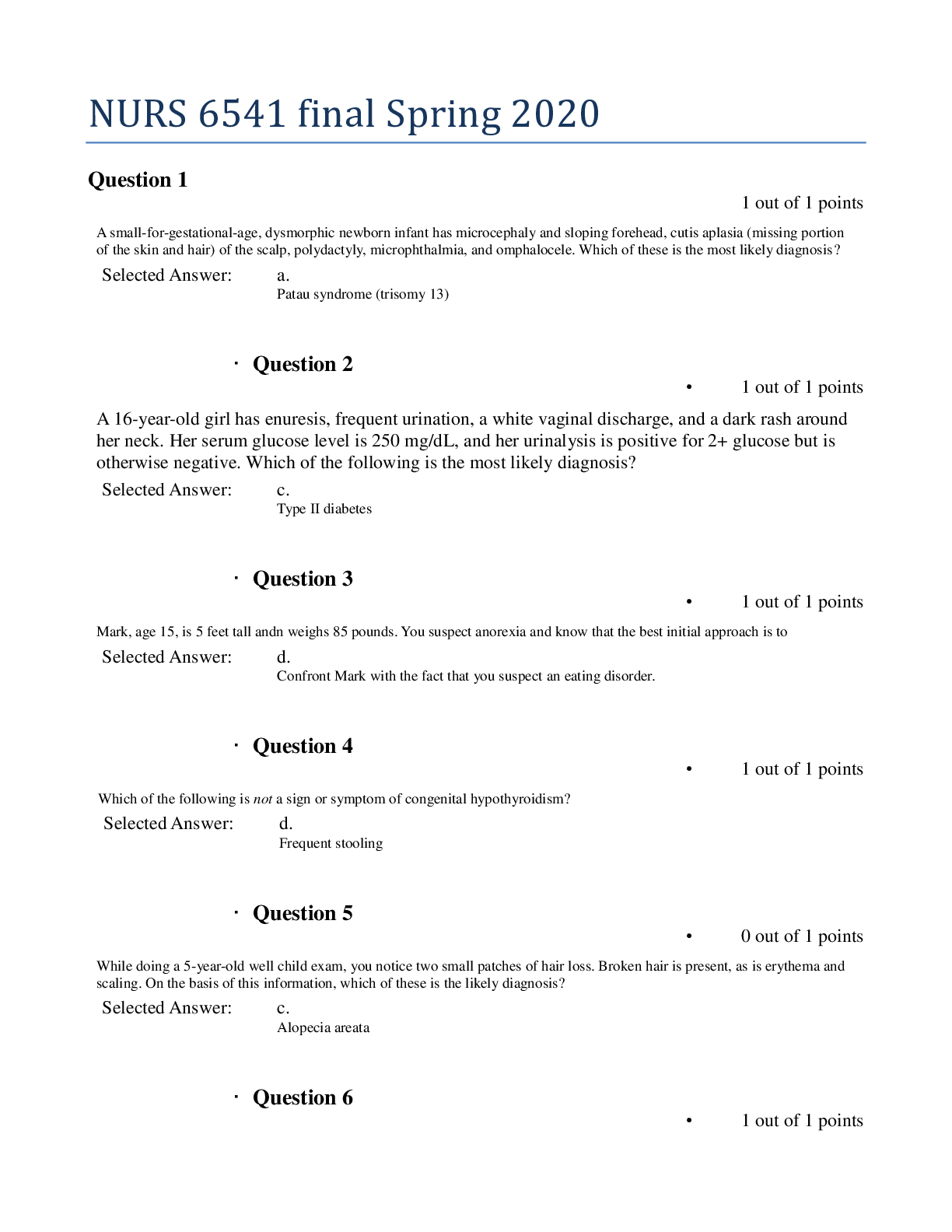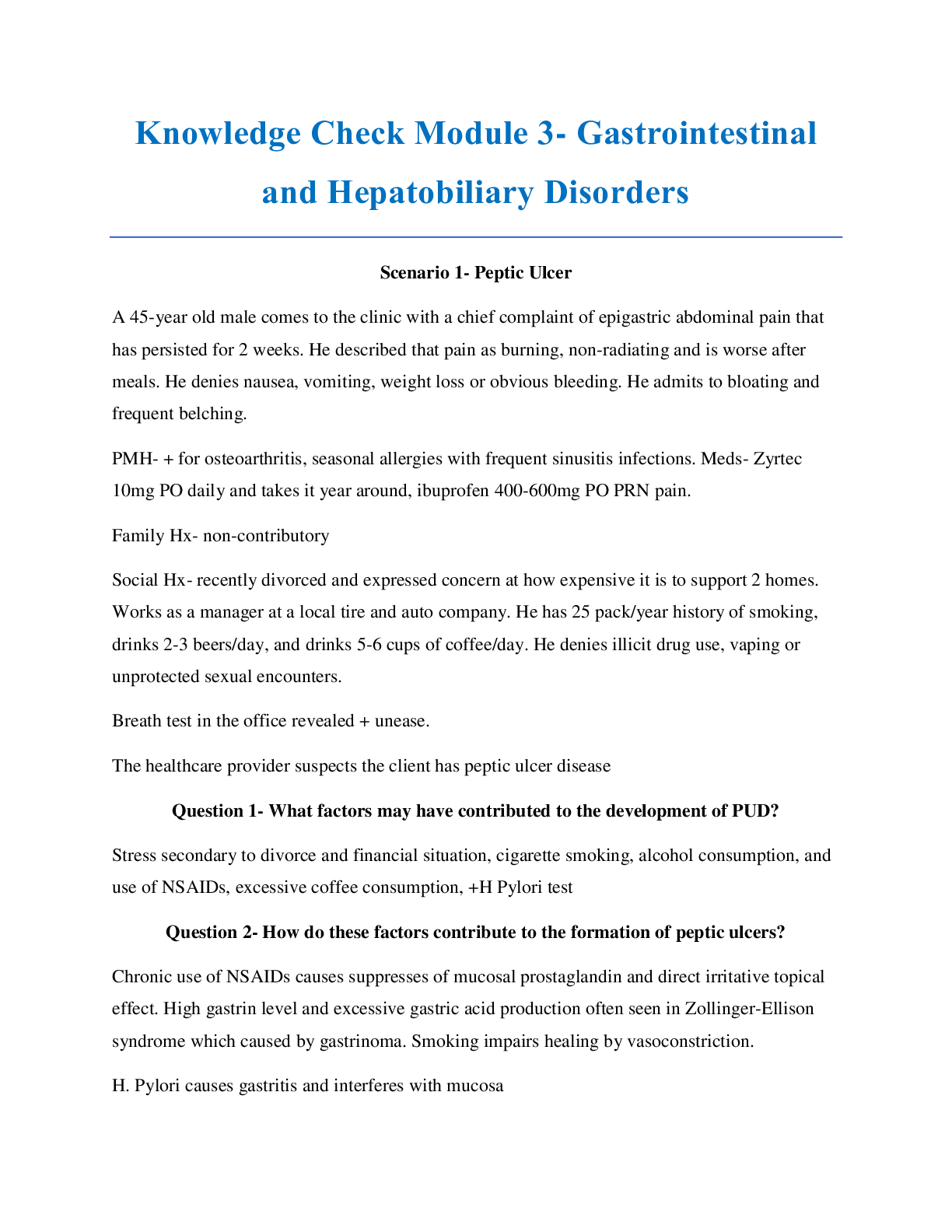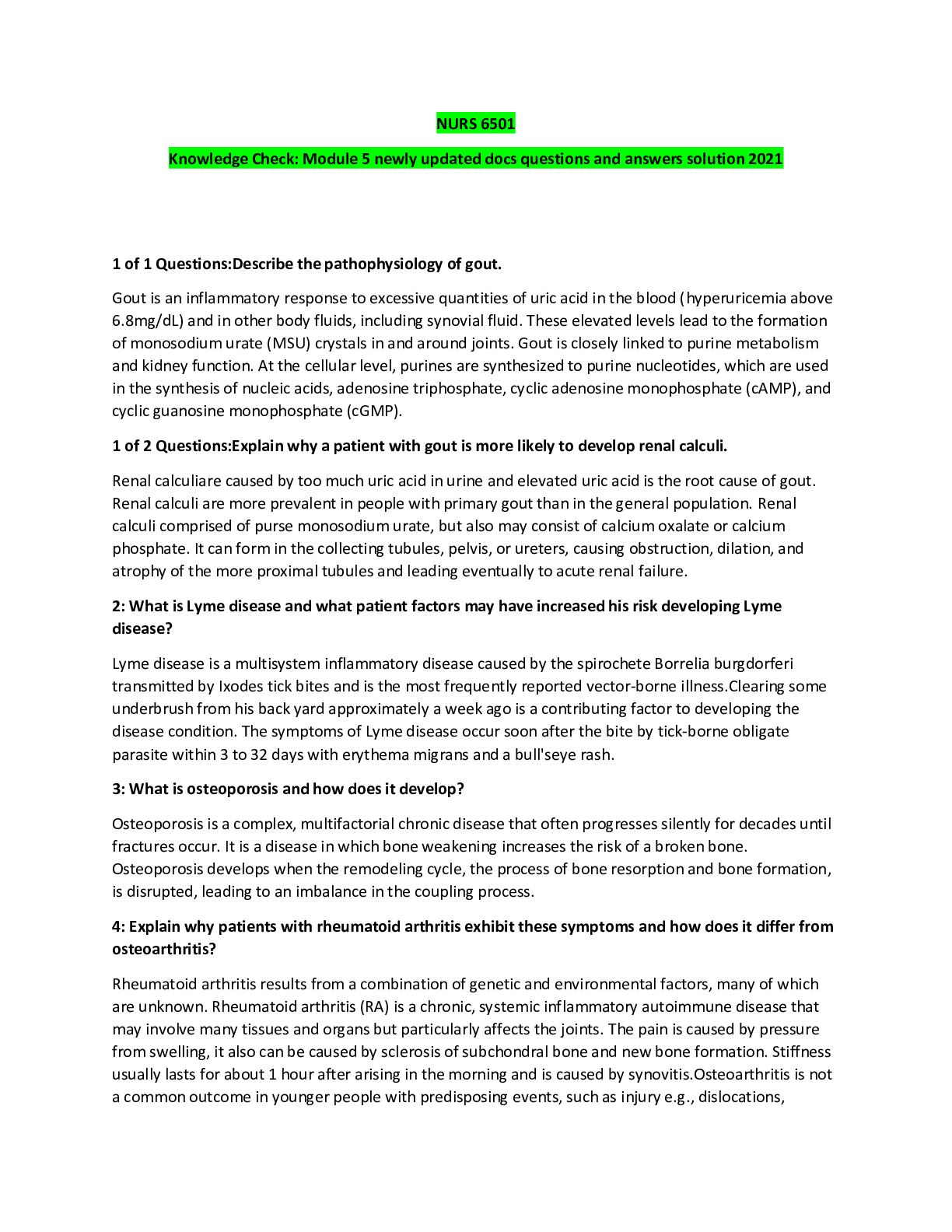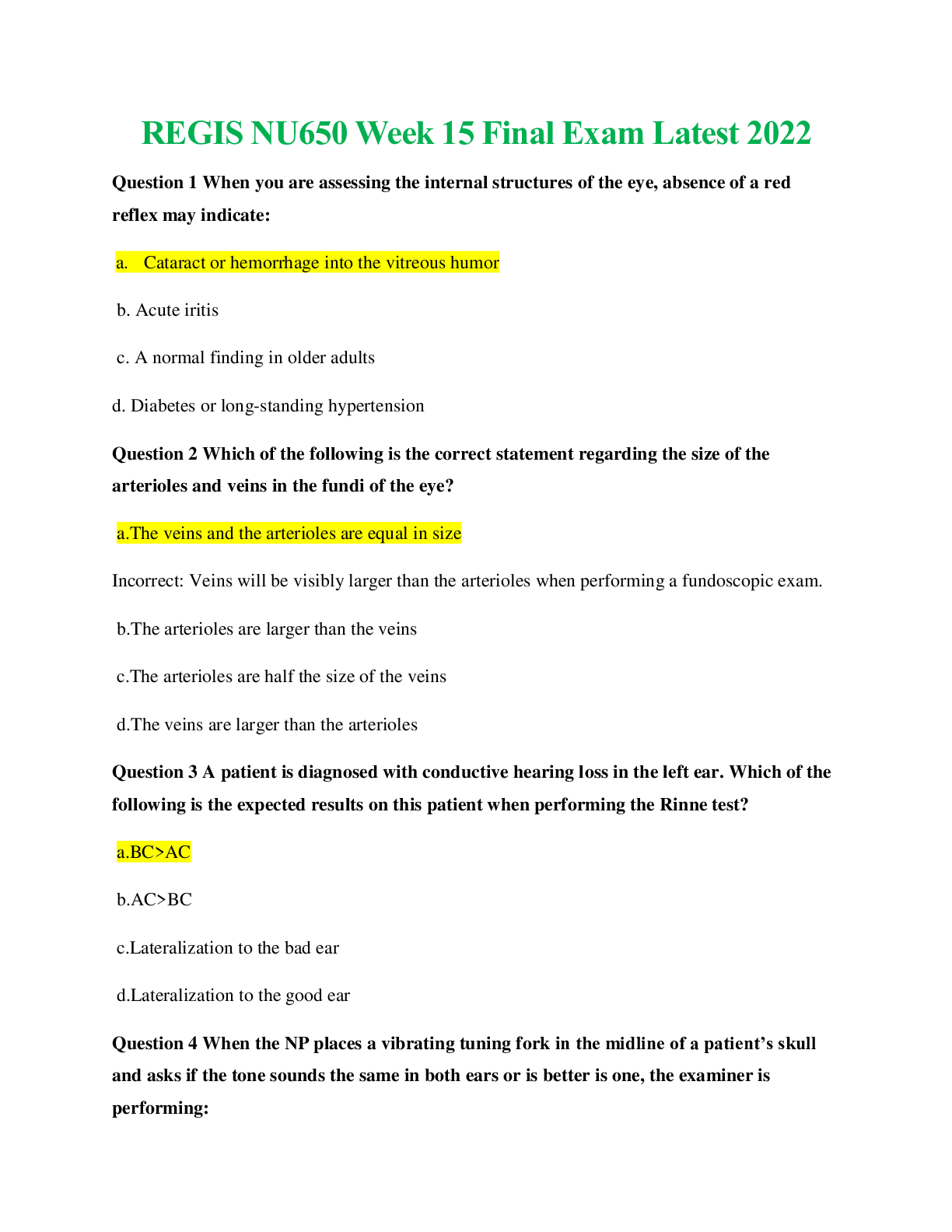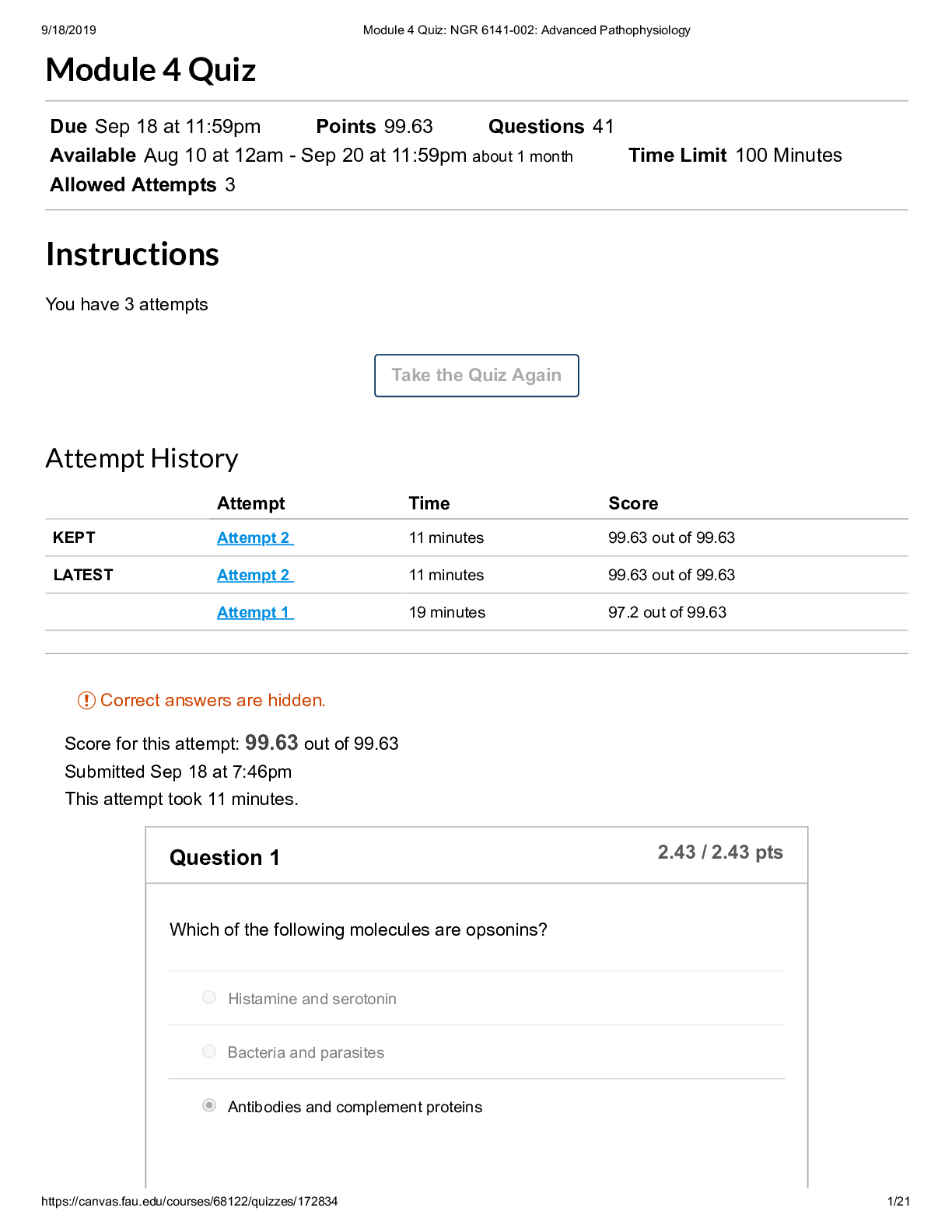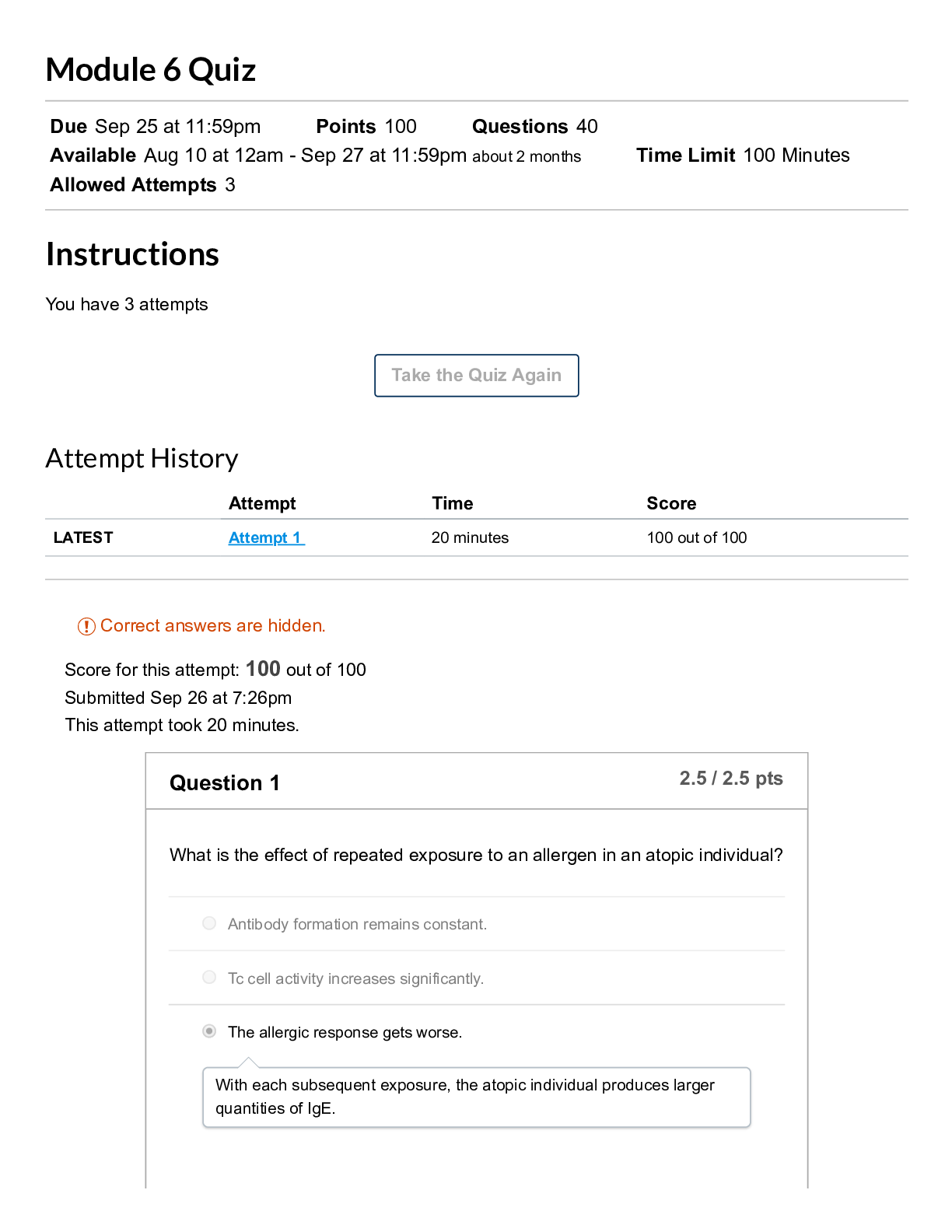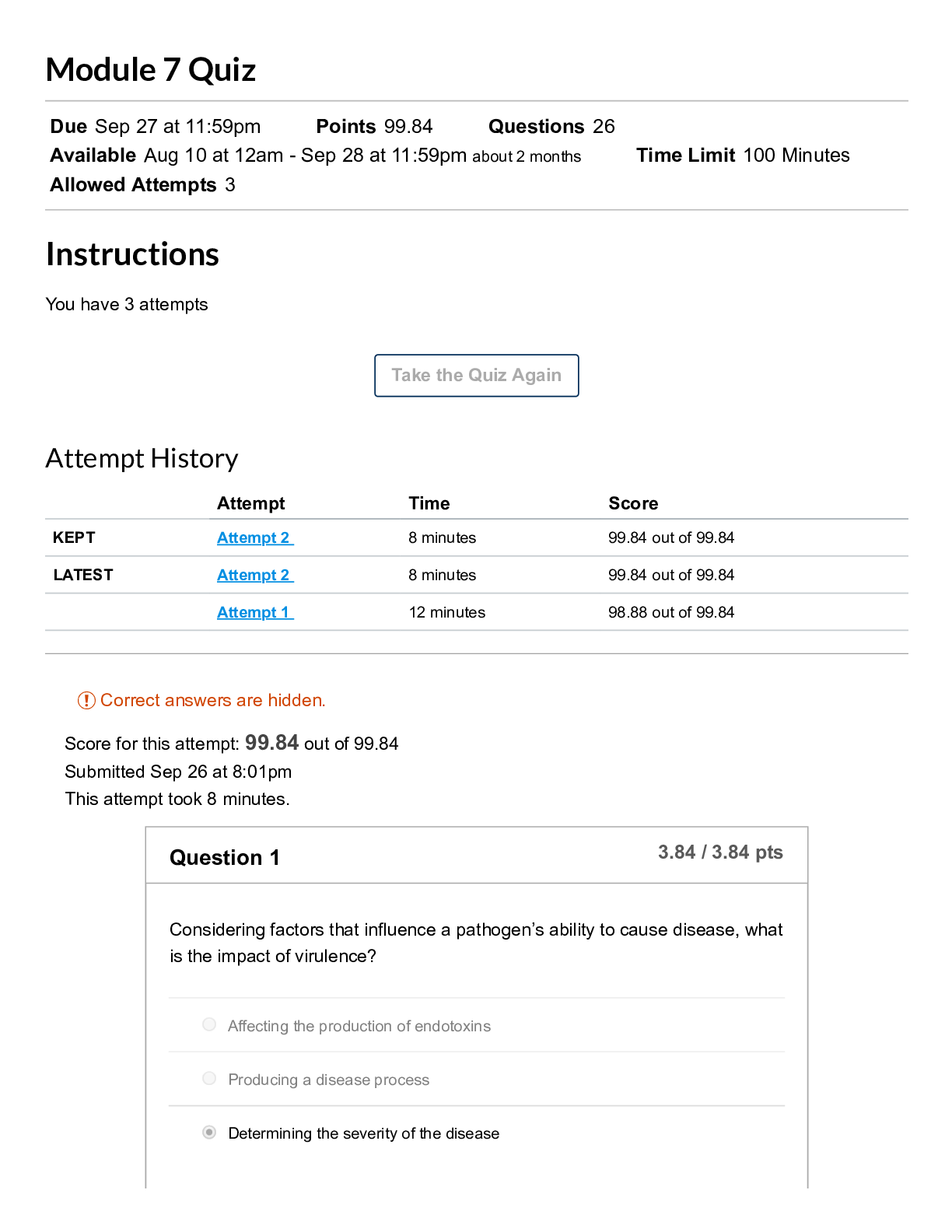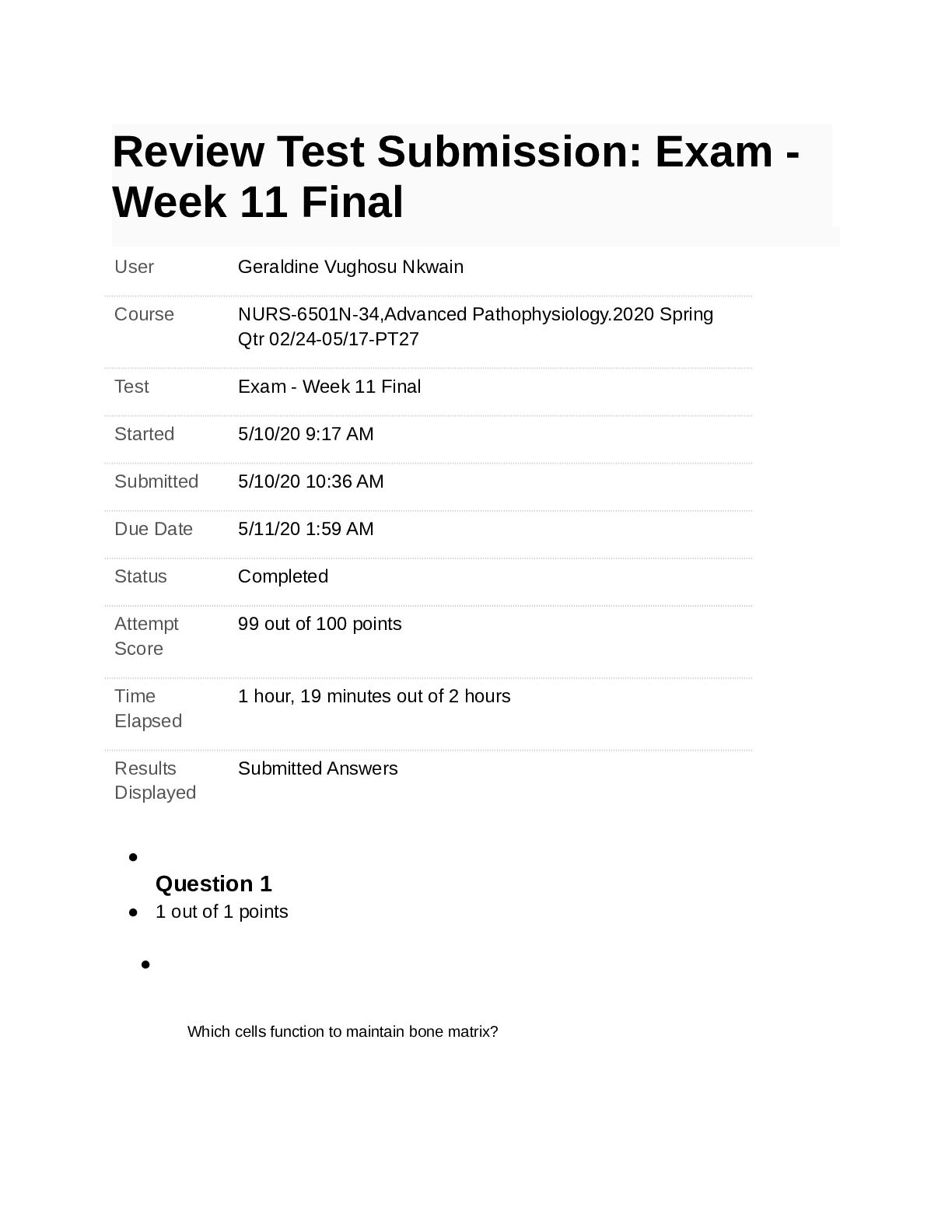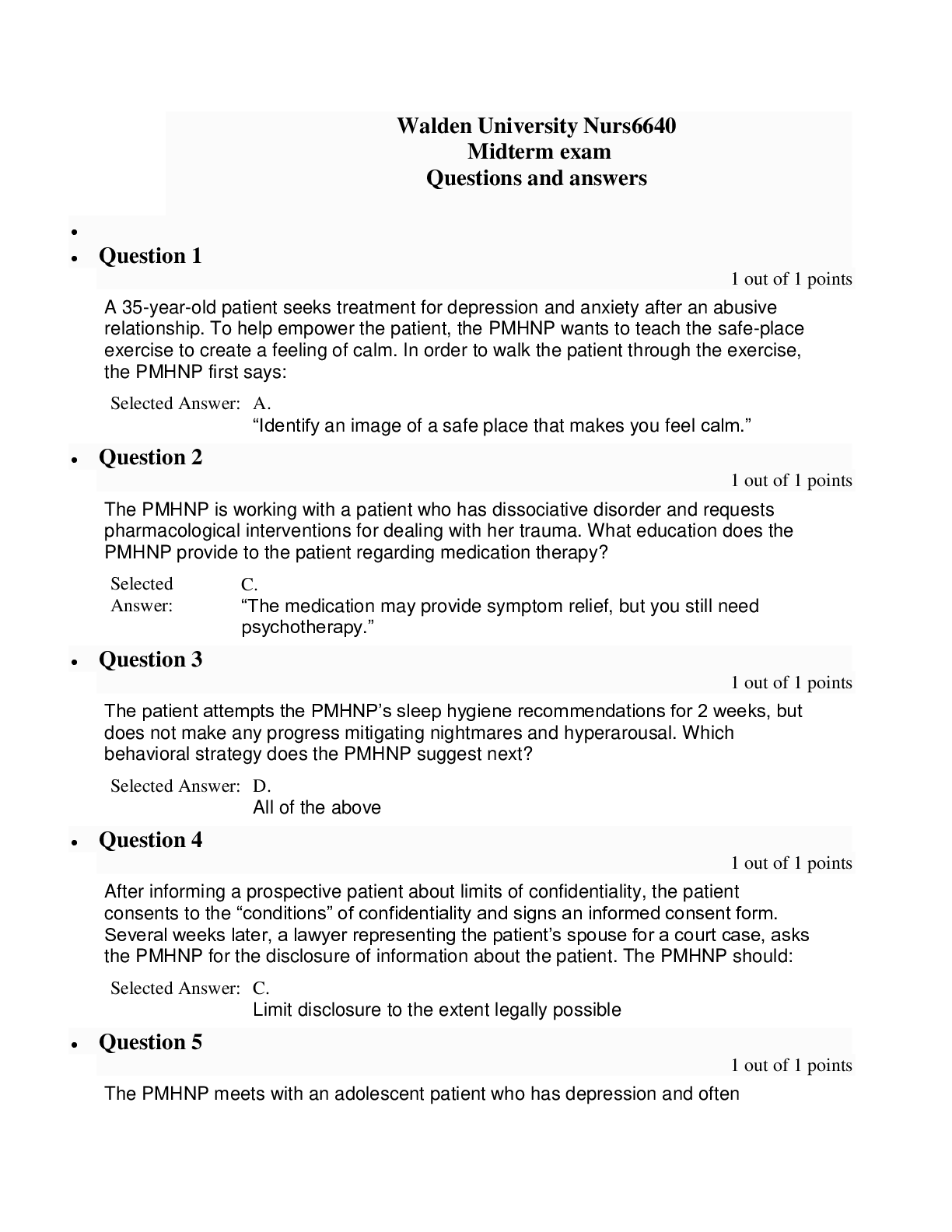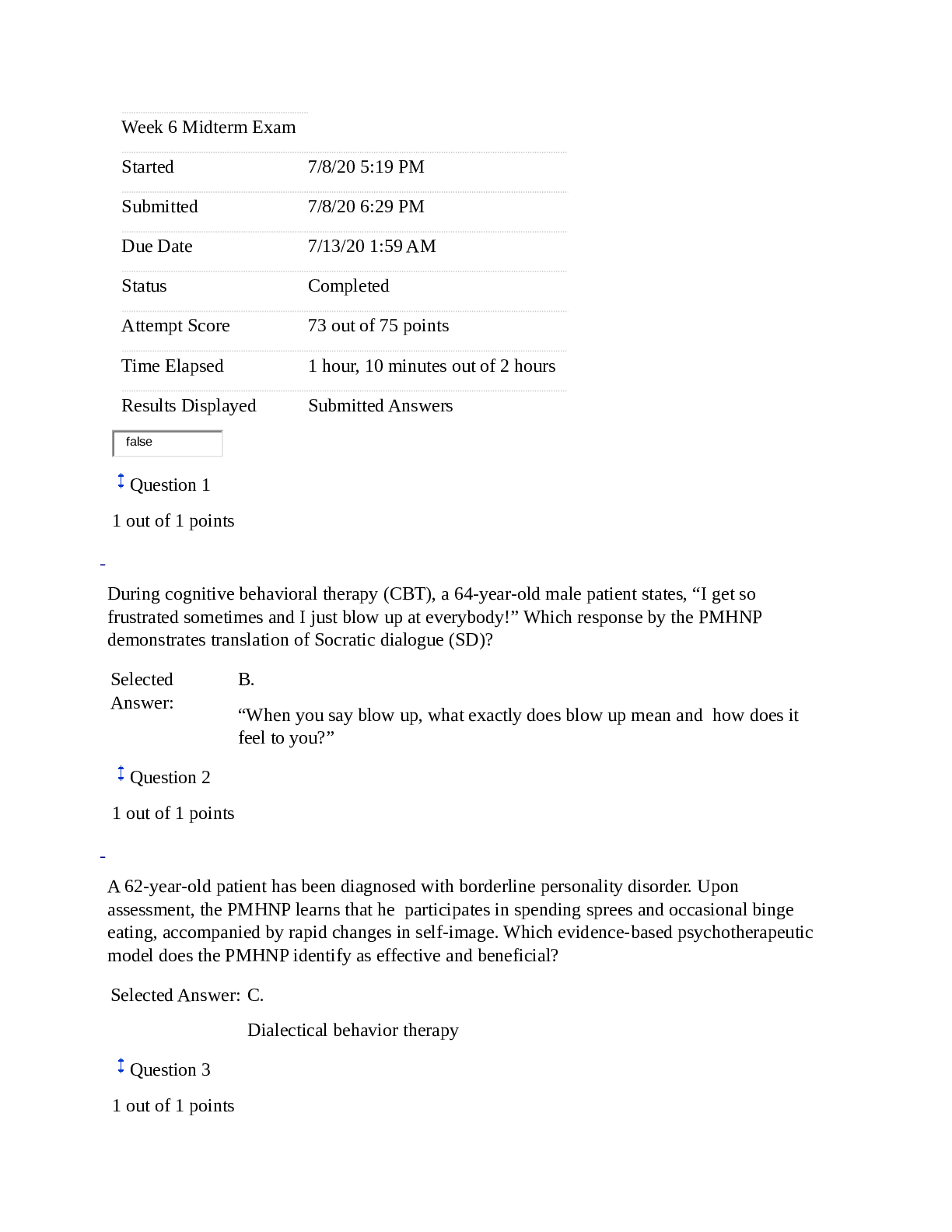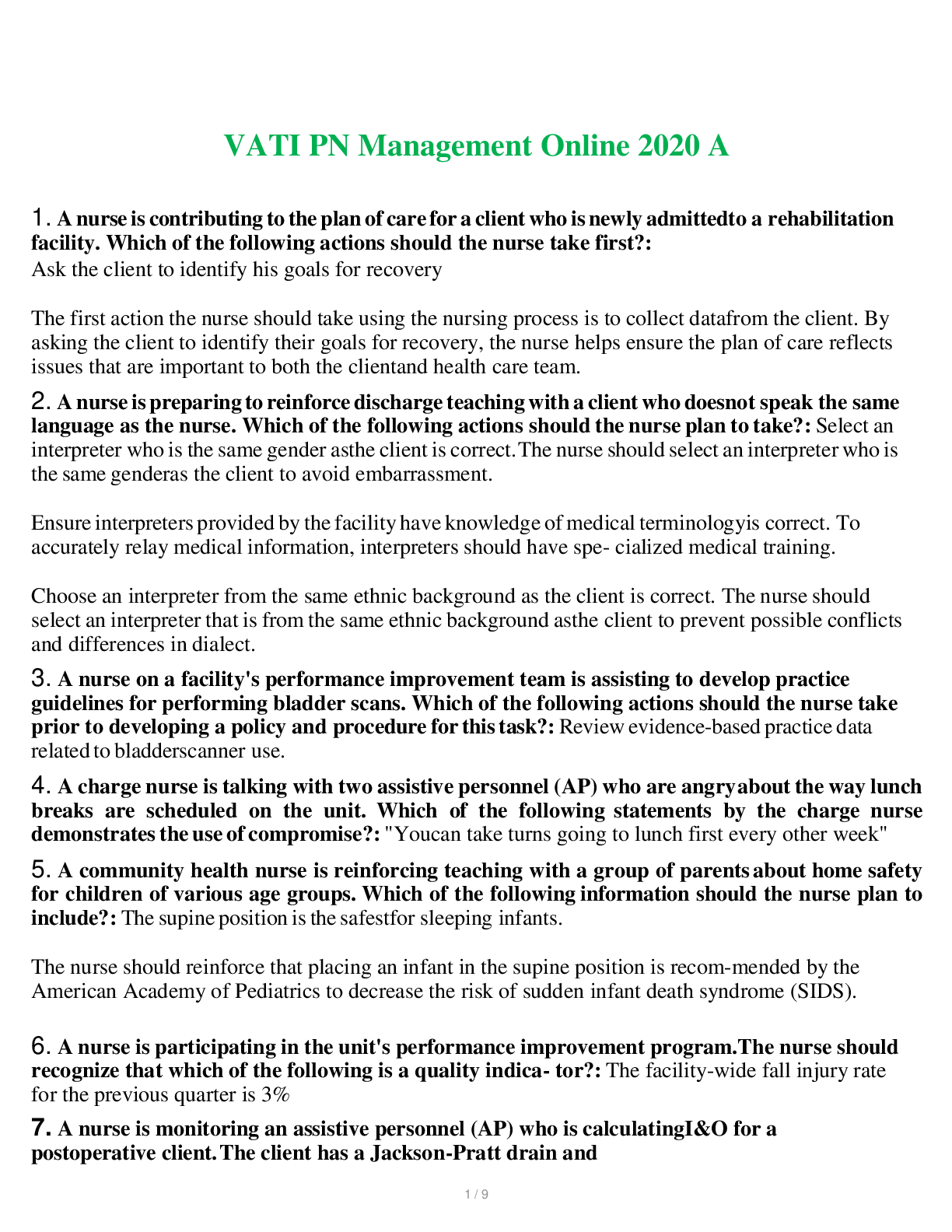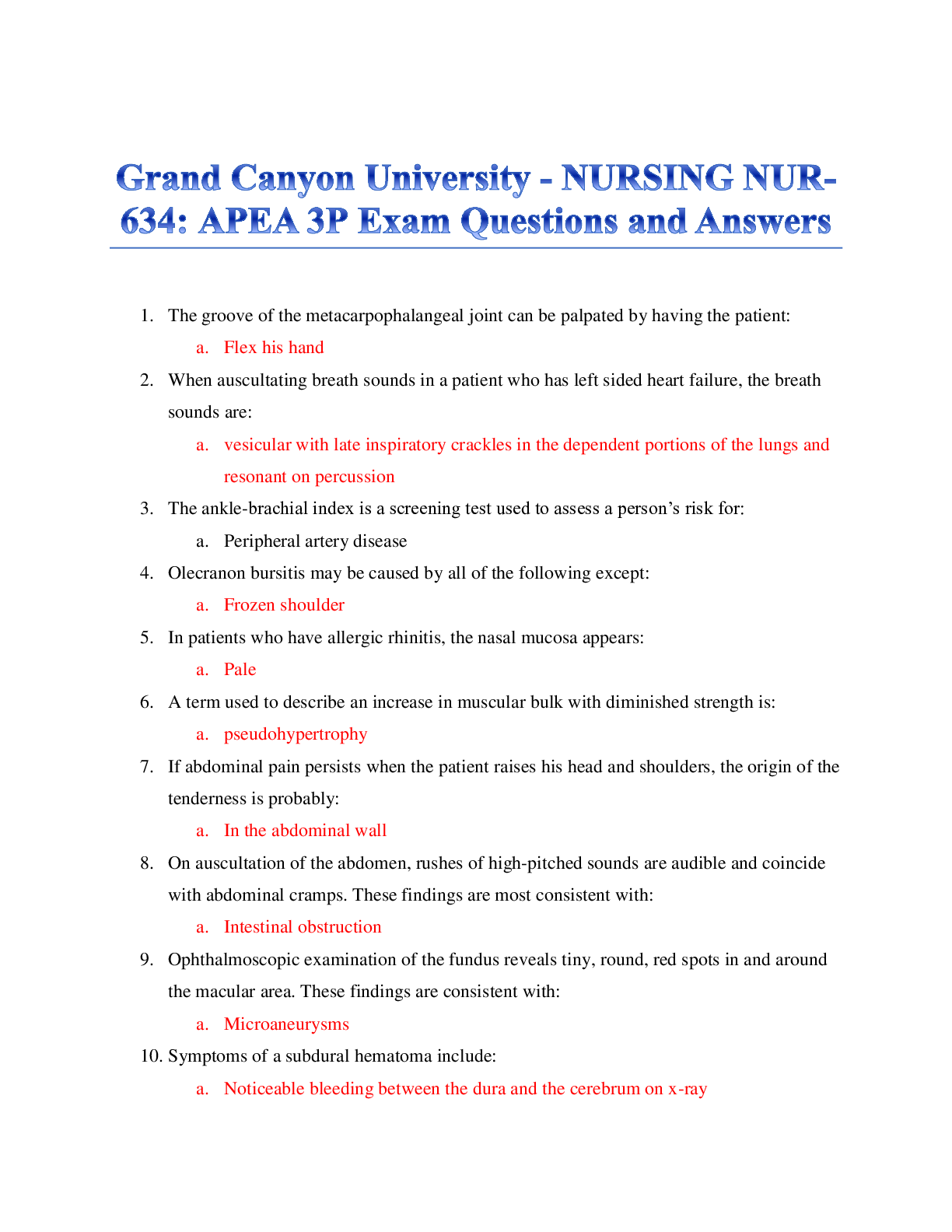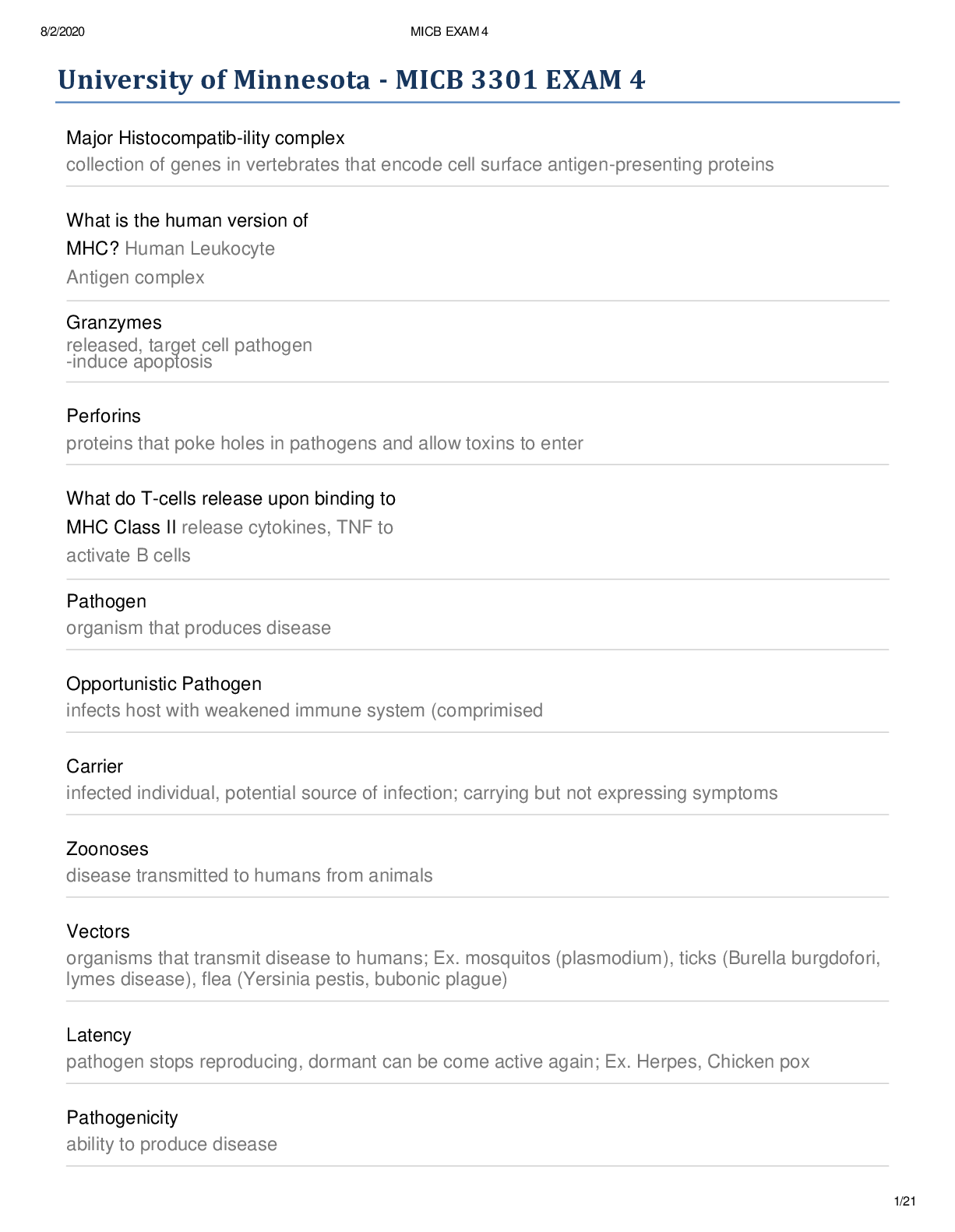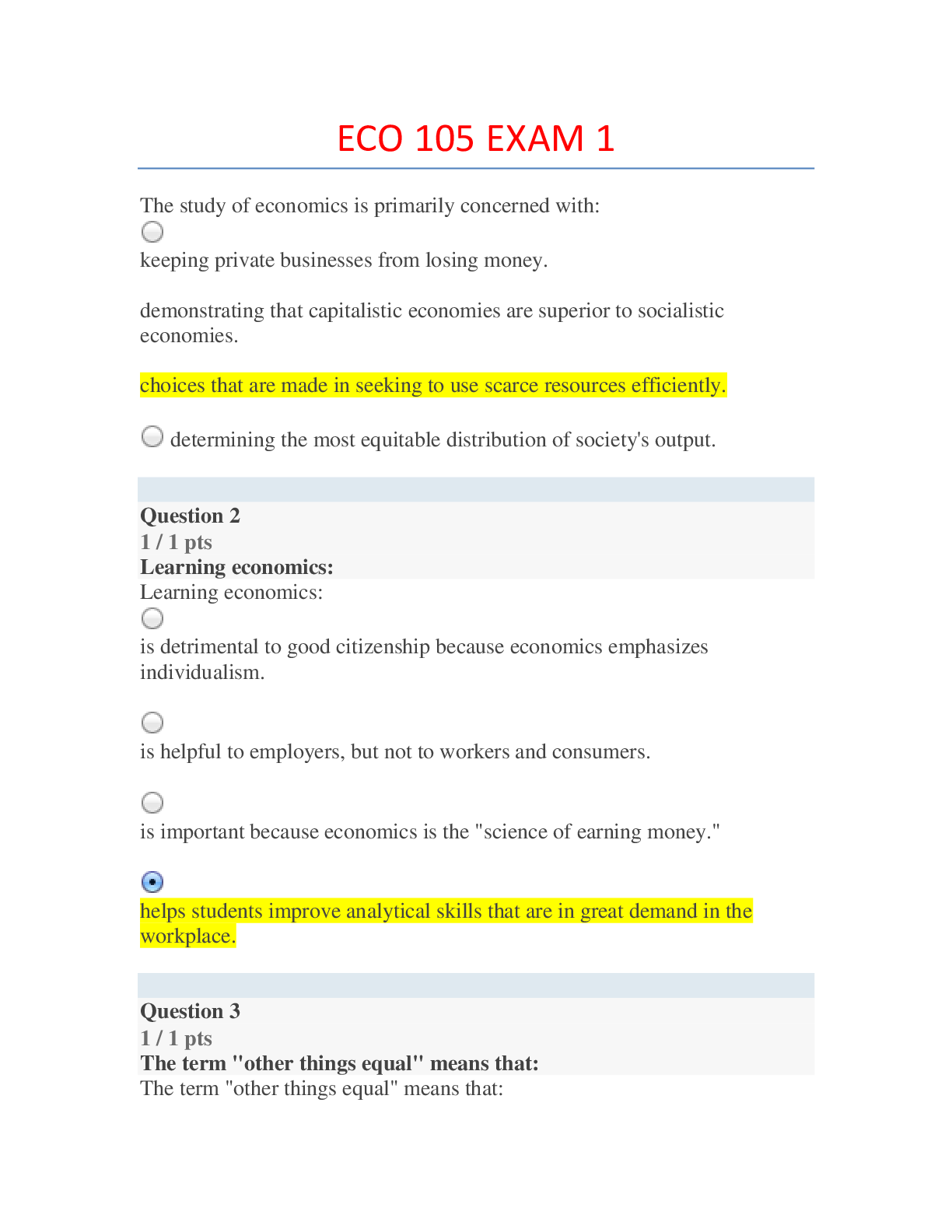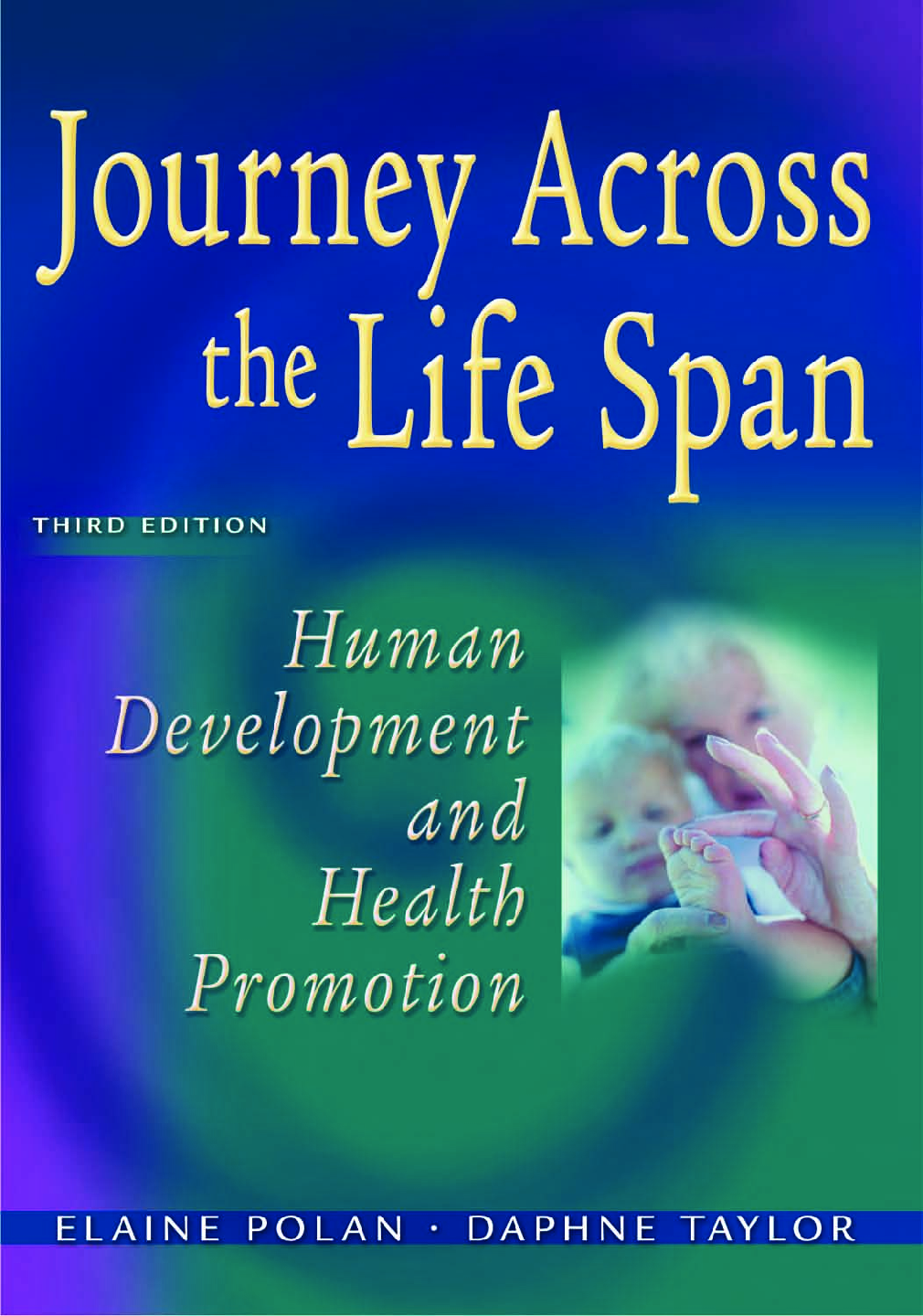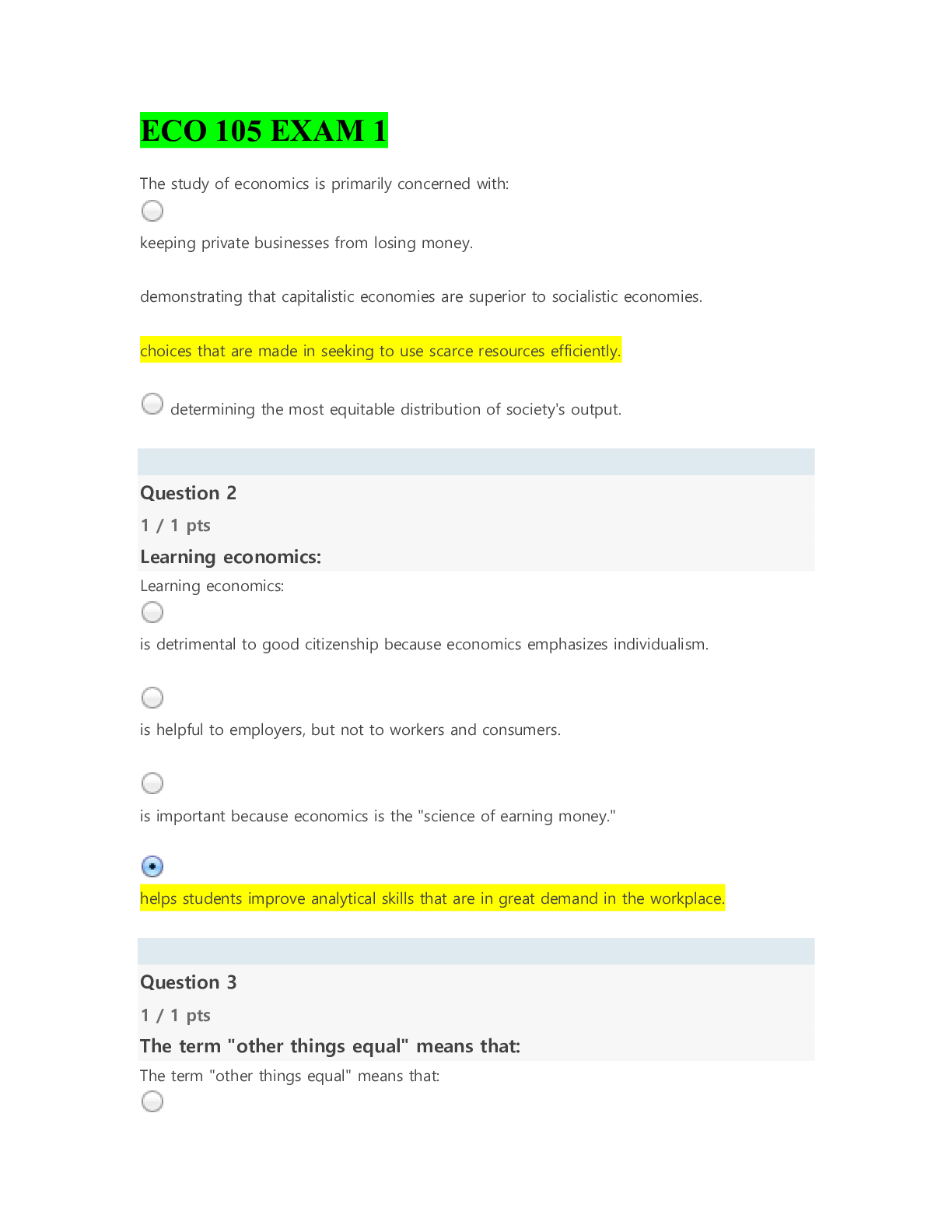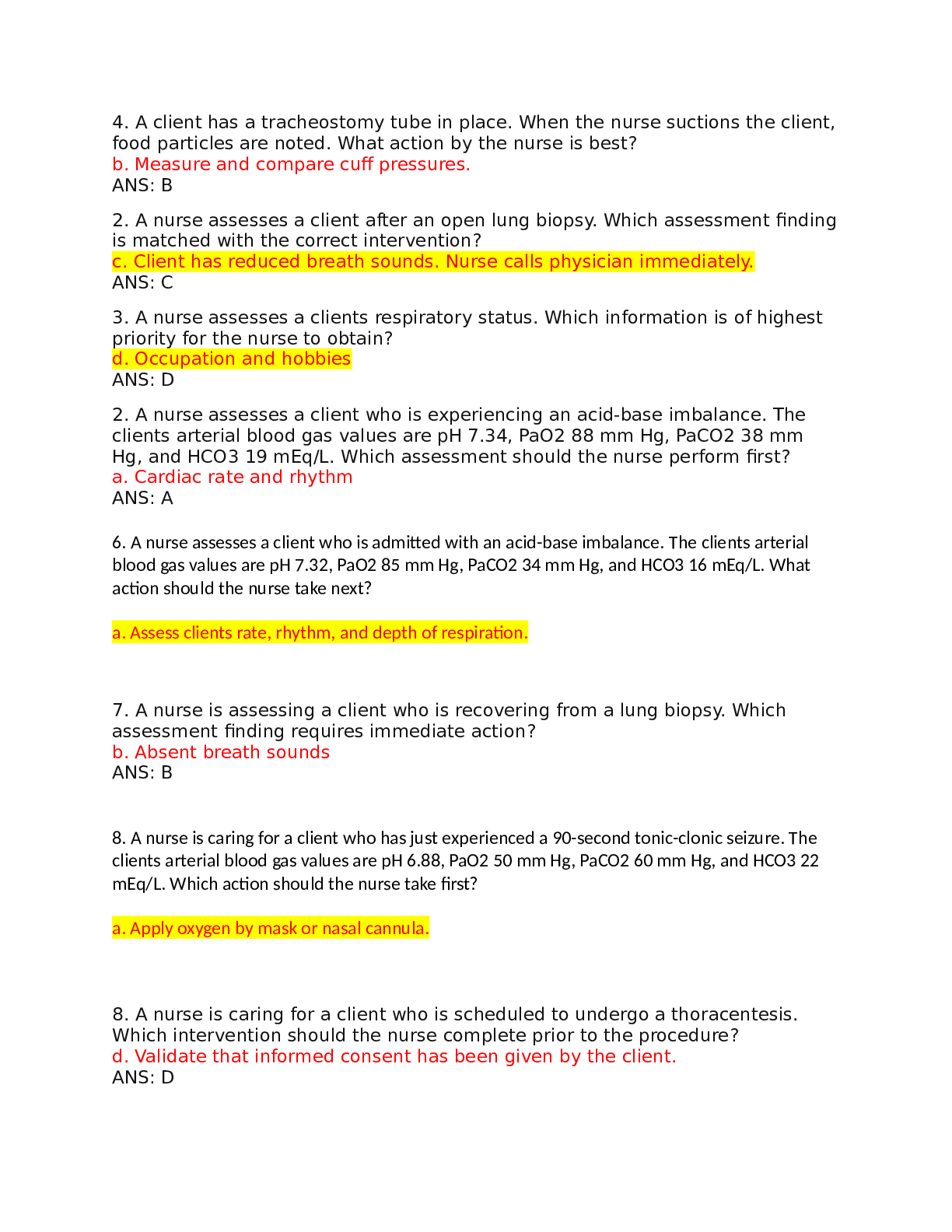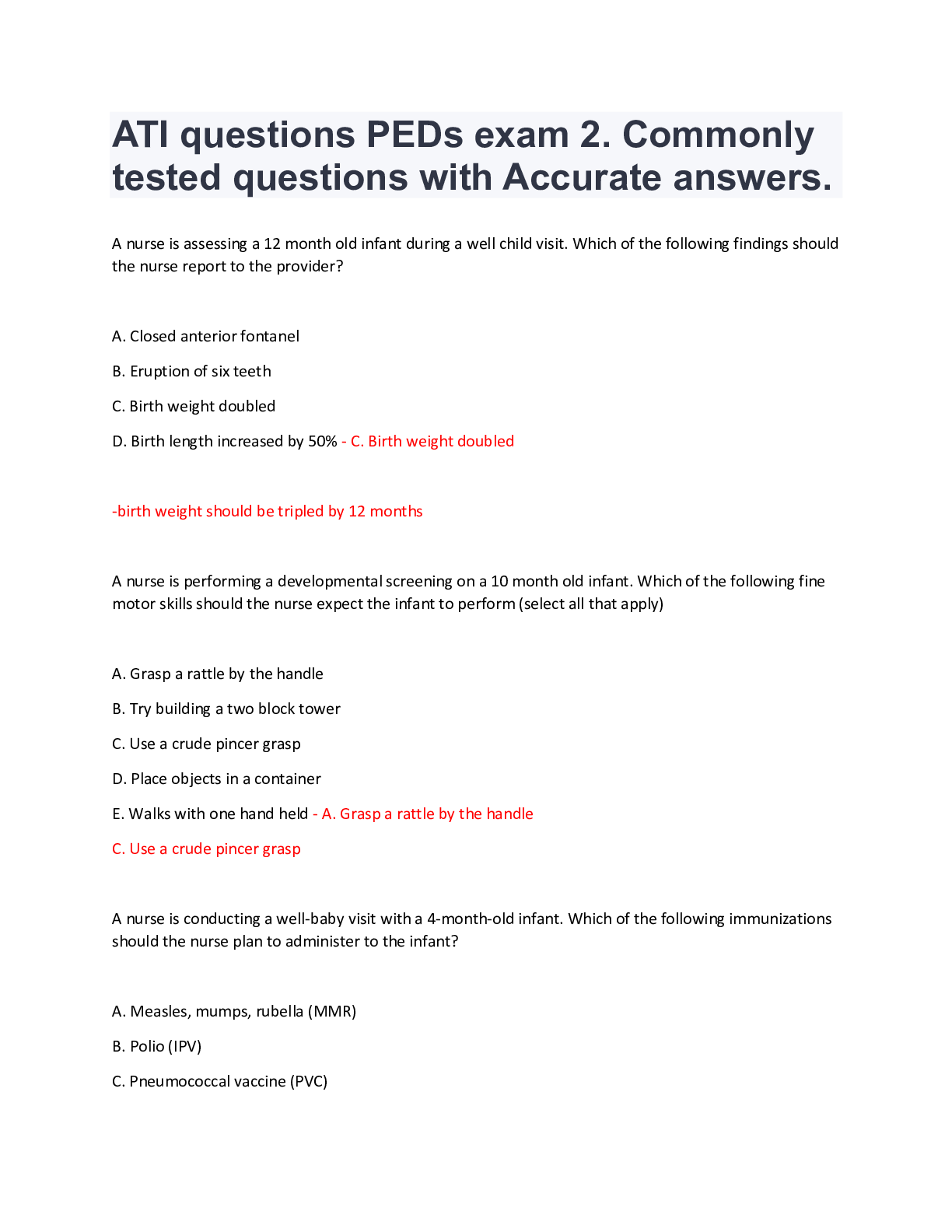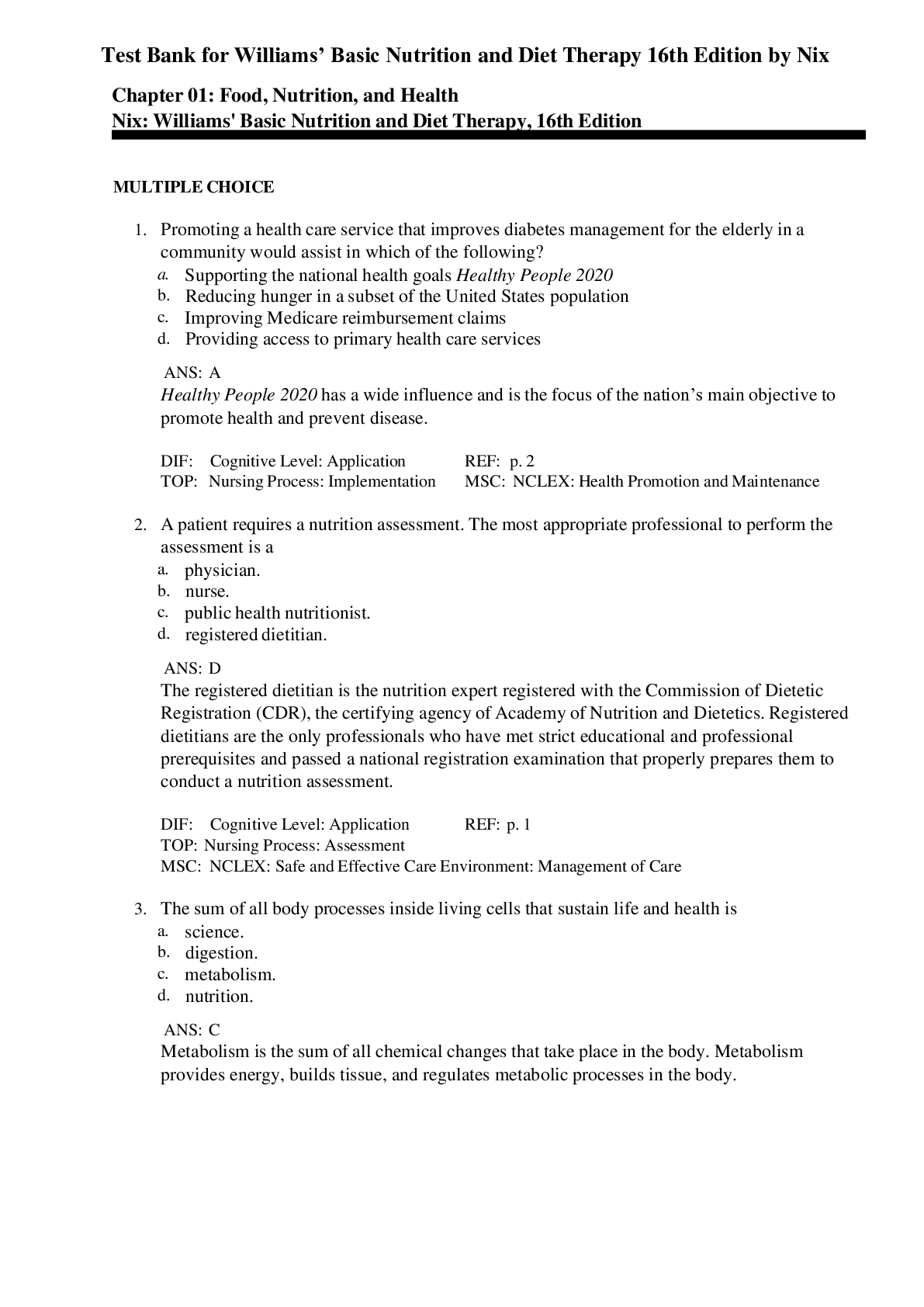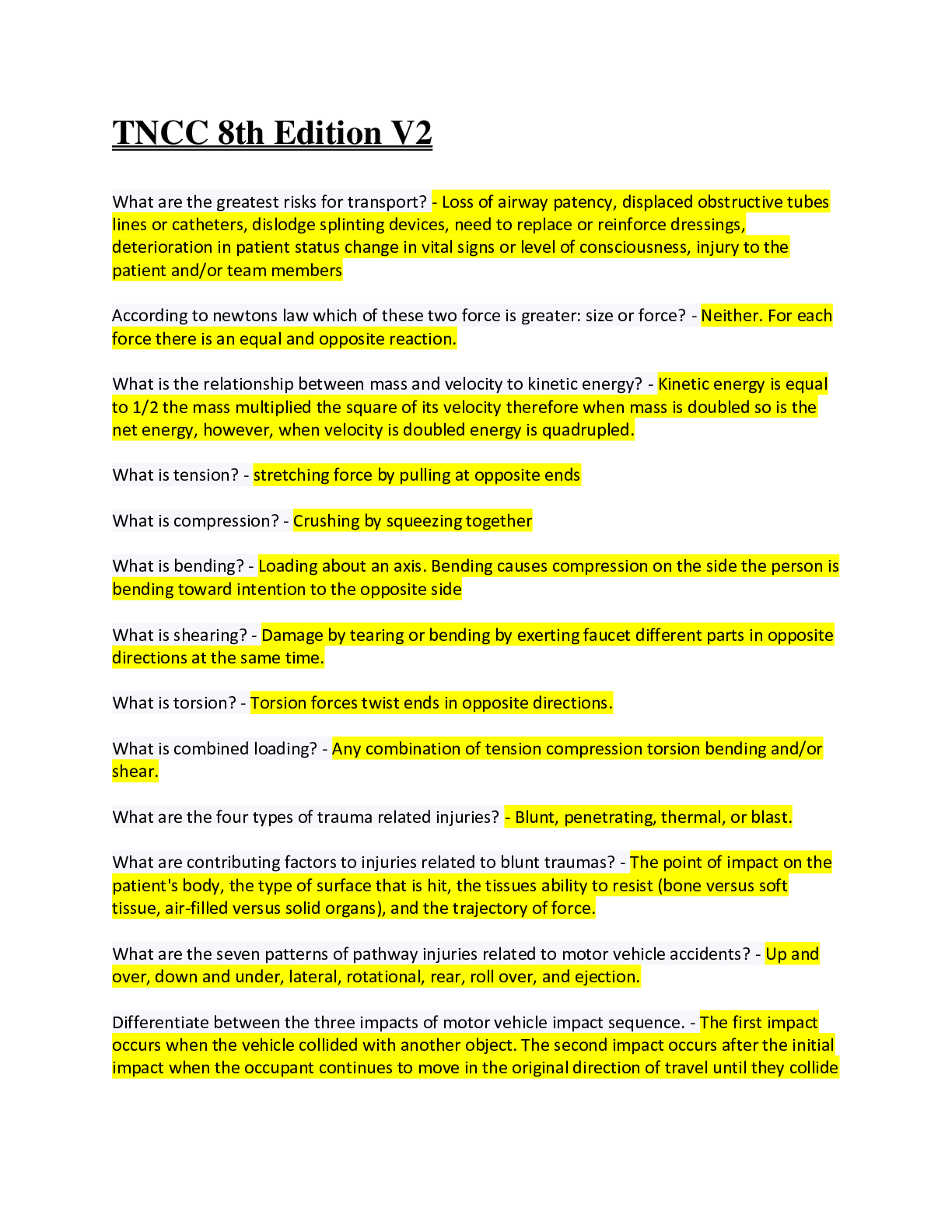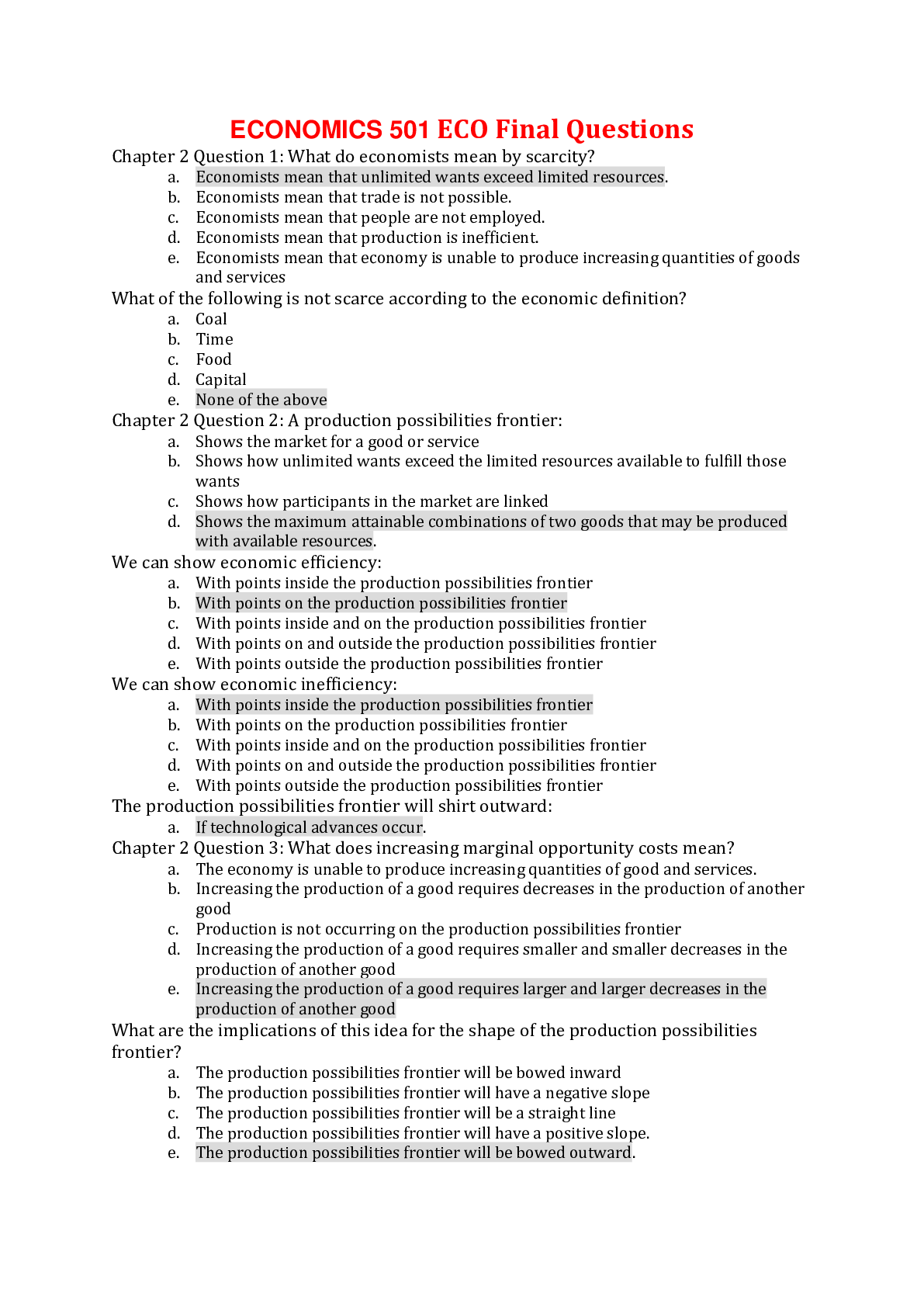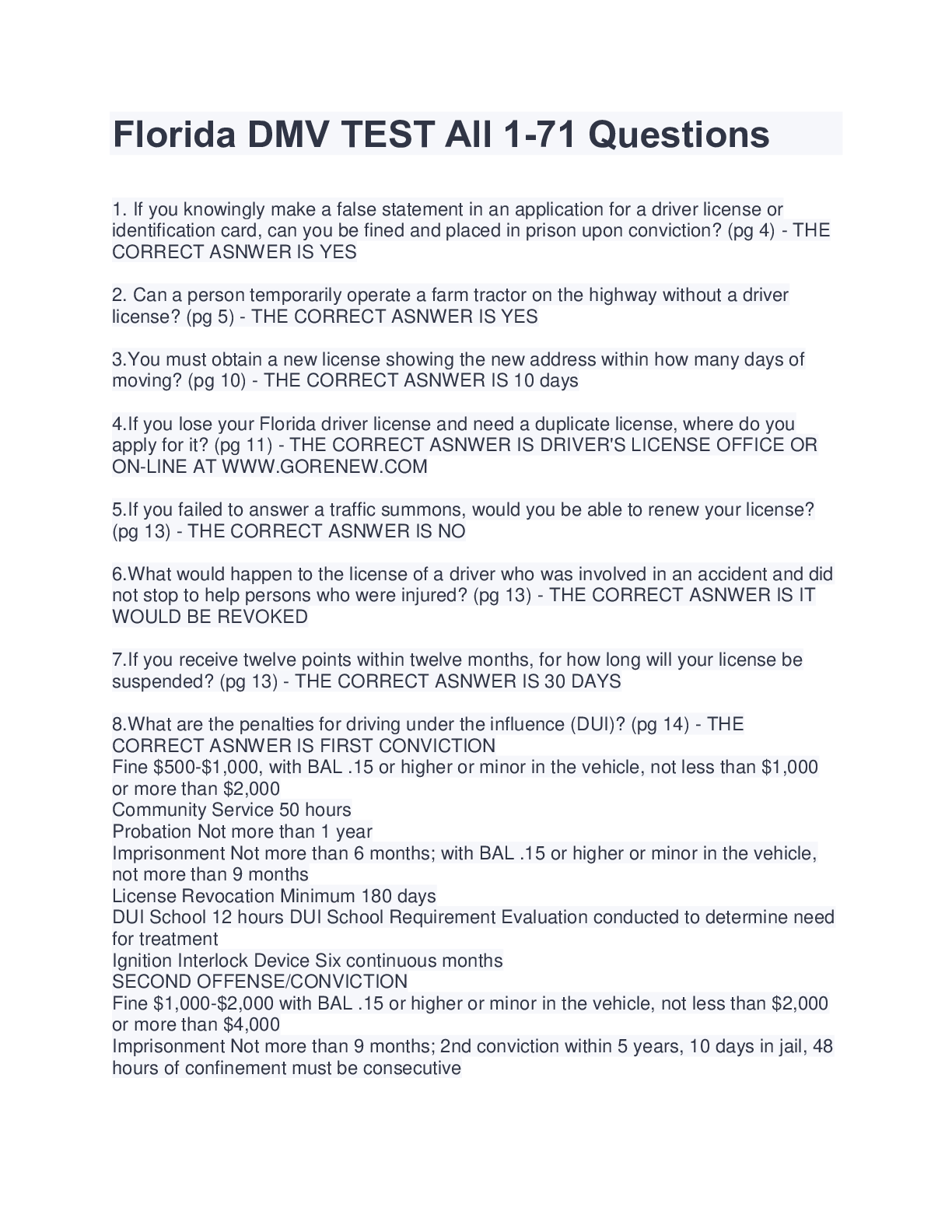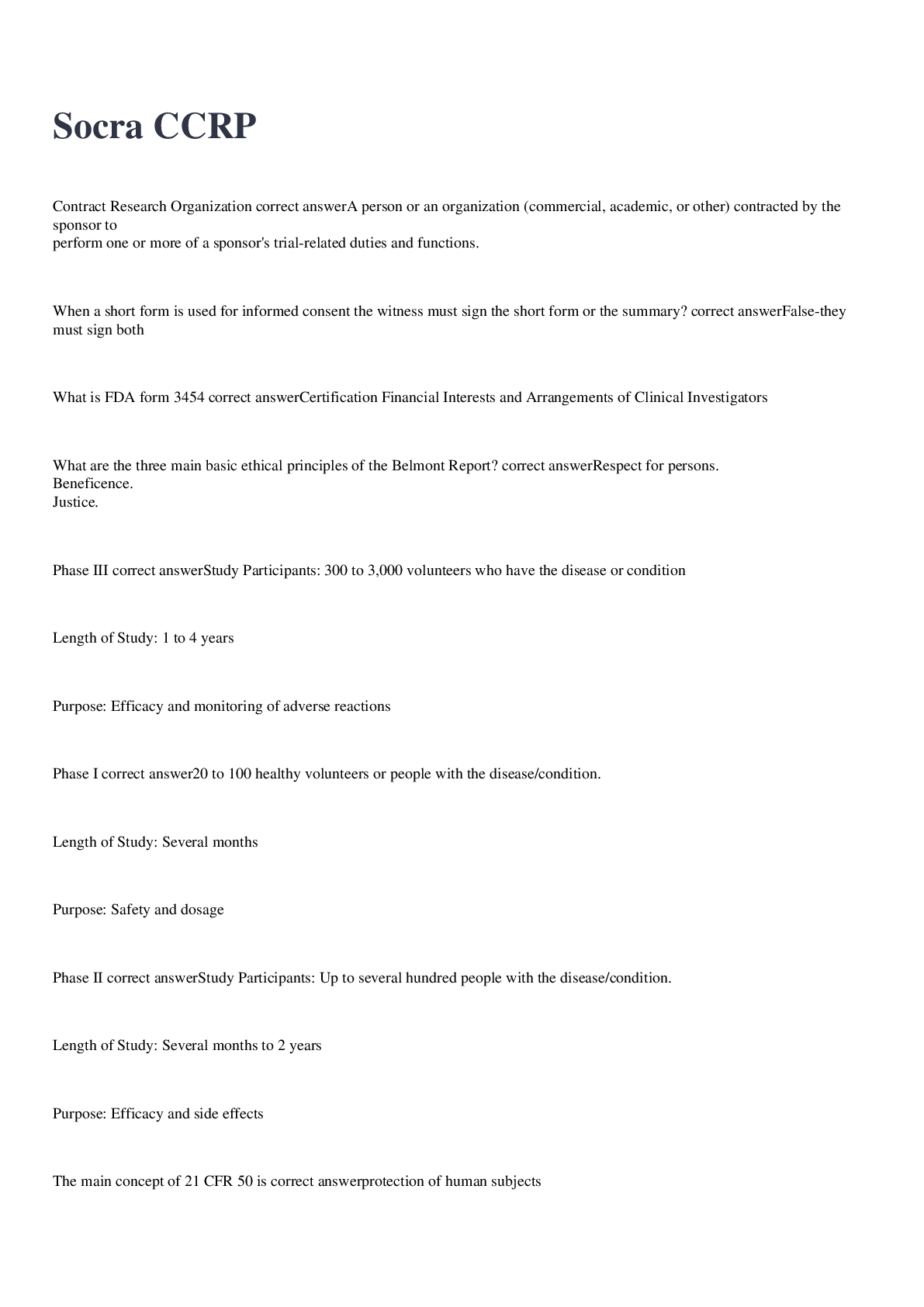*NURSING > EXAM > Neuro Exam_50 of the Most Commonly Tested Questions and Answers. With rationale. (All)
Neuro Exam_50 of the Most Commonly Tested Questions and Answers. With rationale.
Document Content and Description Below
Neuro Exam Most Commonly Tested Questions and Answers A client presents with a headache and complaining of vision difficulties. Which cranial nerve might be defective in this client? A) VIII (Ve... stibulocochlear) B) VII (Facial) C) XI (Accessory) D) III (Oculomotor) A client presents to the ED with loss of consciousness. The RN evaluates the client using the Glasgow Coma Scale. The results are as follows: Eyes open to speech Abnormal flexion of extremities Use of inappropriate words What would the RN estimate this client's GCS score to be? A) 13 B) 9 C) 7 D) 4 Eyes open to speech = 3 Abnormal flexion = 3 Inappropriate words = 3 The RN is receiving report from the night-shift nurse about a patient on the neuro unit. The night-shift nurse states that the client has had decreased proprioception throughout the night. The RN knows tthis means that A) The client has difficulty sensing their position and posture. B) The client's pupils are different sizes. C) The client' has the inability to perform purposeful movements. D) The client is exhibiting symptoms on the opposite side of the body from the brain injury. The RN is caring for a client on a neuro unit who has sustained a head injury. The RN knows that if the pressure of either the brain, CSF, or blood goes up, the other two intracranial components must go down to compensate. This is known as the A) Orem's Self-Care Deficit theory B) Monroe-Kellie hypothesis C) Kolcaba's hypothesis D) Peplau's Neurological Compensation theory Which of the following can lead to cytotoxic edema? (SELECT ALL THAT APPLY) A) Ischemia B) Hyperglycemia C) Hyponatremia D) SIADH E) Cardiac arrest F) Cushing's triad , C, D, E *Anything involving decreased oxygenation can lead to cytotoxic edema. The RN is taking care of a patient on the neuro unit. The night-shift nurse indicates in the morning report that the client has sustained a right midline shift during the night. The RN interprets this to mean that the client A) Has fluid accumulating on the right side of the brain. B) Has had a brain herniation through the foramen magnum. C) Has experienced right-sided vasogenic cerebral edema. D) Has fluid accumulating on the left side of the brain. *A "midline shift" simply means that fluid is putting pressure on one side of the brain, pushing it in the opposite direction toward the "midline". EX: A patient with a right-sided subdural hematoma will have a left midline shift. Which of the following is an early indication of a central herniation? A) Coma B) Decreased level of consciousness C) Temperature >100.4 degrees Fahrenheit D) Decorticate posturing A nurse is caring for a patient on the neuro unit with an uncal herniation. The nurse understands that which of the following manifestations are indications of an uncal herniation? (SELECT ALL THAT APPLY) A) Positive Kellog's sign B) Ipsilateral pupil dilation C) Decerebrate posturing D) Positive Babinski reflex E) Same side motor defects F) Cheyne-Stokes respirations , C, D, E, F A patient is being seen on the neuro unit who requires close ICP monitoring. The doctor orders a ventriculostomy. The nurse understands that a ventriculostomy A) does not drain CSF, and can produce a dampened waveform related to occlusion of clots or tissue. B) requires tubing to be flushed with sterile normal saline without preservatives. C) allows concurrent monitoring of ICP as well as a CSF drainage system. D) is the least invasive device for indirectly monitoring ICP that puts the patient at the lowest risk for infection or hemorrhage. A patient presents to the ED with symptoms of brain herniation. The nurse knows to assess for Cushing's response, which includes A) Widening pulse pressure, decreasing systolic BP, and bradycardia. B) Widening pulse pressure, increased systolic BP, and tachycardia. C) Bradycardia, hypertension, and abnormal respirations. D) Bradycardia, widening pulse pressure, and rising systolic BP The patient with brain herniation has been assessed, and he is progressing from Cushing's response to Cushing's triad. The nurse understands that she needs to monitor for which of the following for progression to Cushing's triad? A) Widening pulse pressure, decreasing systolic BP, and bradycardia. B) Widening pulse pressure, increased systolic BP, and tachycardia. C) Bradycardia, hypertension, and abnormal respirations. D) Bradycardia, widening pulse pressure, and rising systolic BP After stabilizing the patient with brain herniation in the ED, he is sent to the neuro ICU for continued monitoring with an epidural transducer. The nurse understands that an epidural transducer A) is the least invasive device for indirectly monitoring ICP that puts the patient at lowest risk for infection or hemorrhage. B) allows concurrent monitoring of ICP as well as a CSF drainage system. C) does not drain CSF, and can produce a dampened waveform related to occlusion by clots or tissue. D) requires tubing to be flushed with sterile normal saline without preservatives. An ABG has been ordered for a patient receiving continuous ICP monitoring. Which of the following results requires immediate attention by the nurse? A) pH 7.40, PaO2 75, PaCO2 45 B) pH 7.30, PaO2 80, PaCO2 34 C) pH 7.50, PaO2 70, PaCO2 50 D) pH7.48, PaO2 90, PaCO2 30 *Increased ICP will cause a rise in pH (>7.45), decrease in PaO2 (<80), and a rise in PaCO2 (>45). A nurse is planning care for a 45-year-old male client with increased ICP on the neuro unit with a Glasgow Coma Scale score of 12. Which of the following should the nurse include in this patient's plan of care? A) Cluster ADLs. B) Provide time for adequate rest periods throughout the day. C) Call the physician and request a spinal tap to test for suspected CSF leakage. D) Allow multiple visitors throughout the day. *Plan of care should include: -Seizure precautions -Monitoring and treating trends, such as BP and LOC. -Space activities throughout the day to provide adequate rest (ADLs should be done in under 5 minutes). -Provide calm, quiet environment. -Limit emotional upset. -Avoid coughing, sneezing, straining with bowel movement, pushing against bedrails, and isometric exercises. Which of the following are diagnostic tests used to detect the presence of increased ICP? (SELECT ALL THAT APPLY) A) Coagulation profile. B) Chorionic villus sampling. C) Computed tomography. D) Cerebral blood flow with transcranial Doppler. E) EEG. F) Amniocentesis. G) Angiography. , D, E, G The nurse is performing a neurologic assessment on a client. The nurse asks the patient to stick out her tongue and move it to one side, then the other. Which cranial nerve is the nurse assessing? A) Olfactory (I) B) Trigeminal (V) C) Facial (VI) D) Hypoglossal (XII) A patient with increasing ICP is in being taken care of by a nurse in the neuro ICU. Lab data shows the following: pH = 7.38 PaO2 = 88 PaCO2 = 45 Serum osmolality = 330 What should the nurse's priority action be based upon these lab values? A) Continue to monitor the patient. B) Contact the health care provider and request an order for mannitol. C) Assess drainage from the parenchymal fiber-optic catheter. D) Administer furosemide (Lasix) as ordered. *All values are within normal limits. Normal Levels: pH = 7.35-7.45 PaO2 = 80-100 PaCO2 = 35-45 Serum osmolality = 280-300, but maintained above 325 to maintain cerebral perfusion in patients with IICP. The nurse is caring for a patient on the neuro unit with a brain hemorrhage, which has been causing a left midline shift. The nurse anticipates the doctor ordering which of the following tests to show the progression of the hemorrhage? A) CT scan B) MRI C) Cerebral flow w/transcranial Doppler D) EEG The nurse on a neuro unit is assessing her patient at the beginning of the night shift. After the assessment, the nurse notices the following: Eyes open to speech Obeys commands Pleasantly confused Based on the GCS score for this patient, what can the nurse conclude? A) The client has a mild brain injury. B) The client has a moderate brain injury. C) The client has a severe brain injury. D) The client is in a coma. The nurse is caring for a patient with increased ICP who is showing signs of Cushing's triad. Which of the following nursing interventions will the nurse provide for this patient? (SELECT ALL THAT APPLY) A) Keep CPP >/= 70 mmHg B) Place client in Trendelenburg position C) Assess LOC D) Elevate HOB no more than 30 degrees E) Encourage vigilant coughing to expel secretions F) Maintain neutral head position. G) Monitor ICP every 15 min-1 hr. H) Maintain MAP < 70 mmHg , C, D, F, G *CPP should be kept at or above 70 mmHg. *Client's should be placed supine with HOB at no more than 30 degrees. *Frequent neurologic exams, including assessing LOC, are needed. *Avoid coughing, sneezing, or straining. *Maintain a neutral head position with careful side-to- side rotation, when necessary. *IICP needs to be monitored q15m-1h. *MAP must be maintained between 70-95 mmHg. The nurse has taken report from the night shift nurse for a patient who has had an ICP of 25 for the past 15 minutes. The nurse checks the doctor's orders for anticipatory administration of which of the following medications? A) furosemide (Lasix) B) rifadin (Rifampin) C) Mannitol D) labetalol (Trandate) *Osmotic diuretics, such as Mannitol, are used for patients who have a sustained ICP greater than 15-20 for 10 minutes or longer. A patient with IICP has been ordered IVFs to help maintain serum osmolality. The nurse knows that which of the following IVFs would cause the nurse to question the order? A) 0.9% normal saline B) 5% dextrose in water (D5W) C) 0.45% normal saline D) 1/2 normal saline *Patients with IICP are given IVFs to maintain moderate dehydration, which helps to maintain serum osmolality. D5W must always be avoided in these cases due to its hypo-osmolar effects once inside the body. Which of the following medications would the nurse question if ordered for a patient with IICP? A) Acetaminophen 325 mg PO BID B) Ranitidine 150 mg PO q12h C) Dilantin 100 mg PO BID D) Fibrinogen 150 mg/dL *Factor I (Fibrinogen) is a soluble protein in the plasma that is broken down to fibrin by the enzyme thrombin to form clots. This medication will increase ICP. A patient on the neuro unit is scheduled for an angiography at 2:00pm. What should the nurse teach the patient prior to the test? (SELECT ALL THAT APPLY) A) Check for allergies to iodine or seafood. B) NPO 8 hours prior to test. C) Increase fluid intake to 2,000 mL before the test. D) It is not necessary to remove jewelry or dentures prior to this test. E) Possible burning sensation at injection site. F) Possible nausea and salty taste may occur after injection. , B, E, F *Allergies to iodine, seafood, or previous reactions to dye need to be assessed. *Patient must be NPO 8-10 hours prior to test. *All jewelry, dentures, and hair pins must be removed. *Bladder must be emptied prior to test. *There may be a burning sensation at the injection site, as well as nausea and/or a salty taste in the mouth. The doctor has prescribed mannitol for a patient with IICP. The nurse must teach the patient that possible side effects of this medication may include A) Hypertension B) Vasodilation C) Rebound cerebral edema D) Decreased gastric motility The patient on the neuro unit began the day with a BP of 130/78. However, in the past 20 minutes, his BP has decreased to 80/50. What is the priority medication needed for this patient? A) SoluMedrol 30 mg IV q12h B) Dobutamine 1000 mL bolus C) Pantoprazole 80 mg IV q8h D) Brevibloc 0.3 mg/kg/min IV infusion *A 1000 mL IV bolus of dobutamine or dopamine is used for sudden, unsafe low BP. A nurse is caring for a patient diagnosed with status epilepticus. The client begins having another seizure. Which of the following medications would the nurse anticipate administering first? A) Phenobarbital B) Dilantin C) D50 IV solution D) Valium *Valium or Ativan are the first-line treatments to stop seizure activity in status epilepticus. During a seizure in a patient diagnosed with status epilepticus, the nurse knows to do which of the following? (SELECT ALL THAT APPLY) A) Place tongue blade at the bedside. B) Loosen clothing around the neck. C) Attempt to intubate. D) Initiate oxygen therapy via mask. E) Turn patient on their side. , D, E *Loosen clothing around neck. *Turn patient on side. *Put nothing in the mouth. *Administer oxygen via mask. *NO tongue blades at bedside. The patient with status epilepticus is being discharged from the neuro unit. The nurse knows to include which of the following in the patient's discharge teaching? (SELECT ALL THAT APPLY) A) Identify safe leisure activities. B) Avoid alcohol and limit caffeine intake. C) Take showers instead of baths. D) Recognize when the patient is having an aura. E) It's ok not to wear a medical alert bracelet. , B, C, D A client with status epilepticus has been ordered an EEG for later this afternoon. Which of the following nursing interventions should the nurse include for this test? A) Continue administering IV antibiotics as ordered. B) Withhold the next scheduled dose of Dilantin. C) Allow the patient to consume their coffee prior to the test. D) Administer phenobarbital 30 minutes prior to test. A 65-year-old male patient presents to the ED with vomiting, headache, seizures, right-sided hemiplegia, and episodes of loss of consciousness. The patient's medical history indicates frequent visits to the hospital over the past 2 months for sustained hypertension. Based on this information, the nurse understands that this patient is at high risk for which of the following? A) Intracerebral hemorrhagic stroke B) TIA C) Subarachnoid hemorrhagic stroke D) Ipsilateral ischemic stroke. *Intracerebral strokes often occur in older adults with sustained increased systolic BP. A patient diagnosed with ischemic stroke has been prescribed tissue plasminogen activator (tPA) therapy. The nurse checks the client's medical history for which of the following? (SELECT ALL THAT APPLY) A) Blood pressure < 185/110 B) Warfarin therapy C) GI bleed within the past 2 weeks D) Calcium channel blocker therapy within the last 21 days. E) Heparin therapy within the past 48 hours F) PT <15 seconds and INR <1.7 G) Platelet count >100,000 , B, C, E, F, G Criteria for tPA: *Must be administered within 3 hours of symptom onset. *Age > or = 18-years-old *BP </= 185/110 *Not taking warfarin (Coumadin) *Not taken heparin 48 hours prior to tPA administration *No prior intracranial hemorrhage or neoplasm *No GI or urinary bleed within past 21 days (3 weeks) *Clinical diagnosis of ischemic stroke *No major surgical procedures within past 4 days *No seizure at onset of stroke *PT </= 15 seconds and INR </=1.7 *Platelet county >100,000 *No serious head injury or intracranial surgery within past 3 months. A 58-year-old female patient presents to the ED with sudden, explosive headache, stiff neck, and sensitivity to light. A CT of the head is performed and shows fluid at the circle of Willis. Lab data shows the following: ICP = 22 mmHg Na = 125 BP = 185/110 Which of the following medications will the nurse anticipate being ordered for this patient? (SELECT ALL THAT APPLY) A) Nimodipine B) Esmolol C) Dilantin D) Ranitidine E) Hydrocodone F) Colace , C, D, F For a subarachnoid hemorrhage/aneurysm, the client will receive: *Calcium channel blockers (nimodipine) *Anticonvulsants (Dilantin) *Antacids/H2 antagonists (ranitidine) *Stool softeners (Colace) A 17-year-old male patient presents to the ED after a motorcycle accident in which he was not wearing a helmet. The doctor determines that the patient has suffered a basilar skull fracture. What signs and symptoms will the nurse know to assess for with this diagnosis? (SELECT ALL THAT APPLY) A) Butterfly rash B) Battle sign C) Otorrhea D) Rhinorrhea E) Raccoon eyes F) Seizures , C, D, E, F The patient with a basilar skull fracture complains of "feeling something dripping out of my ear". The nurse notices drainage coming from the right ear. The nurse then performs a halo test, which is positive for CSF. What is the next priority action by the nurse? A) Contact the health care provider B) Apply a sterile dressing over the ear C) Send specimen to the lab D) Administer acetaminophen for the patient's headache A patient on the neuro unit is set to undergo a CT scan of the head. It is currently 0800, and the scan is scheduled for 1700. Which of the following nursing interventions should the nurse perform prior to the test? (SELECT ALL THAT APPLY) A) NPO 8 hours before test B) Stop all medications at 1500 C) Ask the patient if they are claustrophobic D) Assess for iodine allergy E) Remove all hairpins, clips, and earrings before test , B, D, E A 40-year-old male patient presents to the ED with a traumatic primary brain injury related to an MVA. Upon assessment, the nurse finds the GCS to be a 6. Which of the following assessment data did the nurse use to come to this conclusion? A) Eyes open to speech; localizes pain; confused. B) Eyes open spontaneously; abnormal flexion; inappropriate words. C) No eye response; flexion-withdrawal; no verbal response. D) No eye response; abnormal flexion; incomprehensible sounds. Eyes Open Spontaneously 4 To speech 3 To pain 2 No response 1 Motor Response Obeys commands 6 Localizes pain 5 Flexion-withdrawal 4 Abnormal flexion 3 Abnormal extension 2 No response 1 Verbal Response Oriented 5 Confused 4 Inappropriate words 3 Incomprehensible sounds 2 No response 1 A patient is admitted to the neuro unit with a GCS score of 8. The patient also has expressive aphasia, memory loss, and impaired logic. The nurse understands that these are symptoms involved in which type of brain injury? A) Left-sided B) Diffuse C) Right-sided D) Uncal herniation A patient presents to the ED with left-sided headache, confusion, left-sided pupil enlargement, and left-sided weakness. As the nurse obtains the patient's history, the wife says, "He just hasn't been acting right since he feel in the kitchen 3 days ago while making us some lunch". Which of the following diagnoses does the nurse anticipate for this client? A) Acute subdural hematoma B) Mild subdural hematoma C) Subacute subdural hematoma D) Chornic subdural hematoma *Sub-acute subdural hematoma occurs within 48 hours-2 weeks after a head injury. Signs/symptoms include unilateral headache, drowsiness, confusion, ipsilateral pupil enlargement, hemiparesis, and respiration changes. The patient who has just undergone craniotomy surgery returns to the neuro unit. Which of the following lab values indicates that the surgery was a success? A) PT = 17 seconds B) BUN = 20 C) Pain = 4 on 0-10 scale D) ICP = 12 *Normal Level ICP = 0-15 mmHg After a client has a seizure, which of the following actions can the nurse delegate to the UAP? A) Documenting the seizure B) Performing neurologic checks C) Taking the client's vital signs D) Restraining the client for protection Which client should the charge nurse assign to the new RN graduate who is on orientation to the neurologic unit? A) 28-year-old newly-admitted client with an SCI. B) 67-year-old who had a stroke 3 days ago and has left-sided weakness. C) 85-year-old with dementia who is to be transferred to long-term care today. D) 54-year-old with Parkinson disease who needs assistance with bathing. *A = RN (new client) *C = RN (discharge teaching) *D = UAP (ADLs) A client with a brain tumor begins having visual disturbances. The nurse understands that this tumor is most likely in which lobe of the brain? A) Frontal B) Cerebellum C) Occipital D) Temporal The nurse on the neuro unit knows that the test of choice in locating brain tumors, as well as defining their size, shape, extent of distorted anatomy, and degree of associated cerebral edema, is a(n) A) EEG B) MRI with gadolinium enhancement C) Arteriogram D) Endocrine study Which client should be assigned to the travelling nurse, new to the neuro unit, who has been on the floor for 1 week? A) 34-year-old with newly diagnosed multiple sclerosis (MS). B) 68-year-old with chronic amyotrophic lateral sclerosis (ALS) C) 56-year-old with Guillain-Barre syndrome (GBS) in respiratory distress. D) 25-year-old admitted with a C4-level spinal cord injury. An elderly patient on the neuro unit diagnosed with a brain tumor and has a nursing diagnosis of Risk for Infection. Which of the following indicates a need for immediate nursing intervention? A) Pain a 6 on 0-10 scale B) ICP = 18 mmHg C) CCP = 75 mmHg D) Constant swallowing *Constant swallowing indicates a possible CSF leak, which requires immediate attention by the nurse. Which actions should you delegate to an experienced UAP when caring for a client with a thrombotic stroke who has residual left-sided weakness? (SELECT ALL THAT APPLY) A) Assisting the client to reposition every 2 hours B) Reapplying pneumatic compression boots C) Reminding the client to perform active ROM exercises D) Assessing the extremities for redness and edema E) Setting up meal trays and assisting with feeding , B, C, E A 23-year-old with a recent history of encephalitis is admitted to the medical unit with new-onset generalized tonic-clonic seizures. Which nursing activities included in the client's care plan will be best to delegate to the LPN whom you are supervising? (SELECT ALL THAT APPLY) A) Observing and documenting the onset and duration of any seizure activity. B) Administering phenytoin (Dilantin) 200 mg PO TID. C) Teaching the client about the need for frequent tooth brushing and flossing. D) Developing a discharge plan that includes referral to the Epilepsy Foundation. E) Assessing for adverse effects cause by new anti-seizure medications. , B *C = Teaching *D = Discharge teaching *E = New medications Which nursing intervention will be implemented first if a client has a generalized tonic-clonic seizure? A) Turn the client to one side. B) Give lorazepam (Ativan) 2 mg IV. C) Administer oxygen via nonrebreather mask. D) Assess the client's level of consciousness. You are caring for a client with a glioblastoma who is receiving dexamethasone (Decadron) 4 mg IV every 6 hours to relieve symptoms of right arm weakness and headache. Which assessment information will concern you the most? A) The client no longer recognizes family members. B) The blood glucose is 234 mg/dL. C) The client reports a continuing headache. D) The daily weight has increased by 1 kg. *Not recognizing family members is a NEW neurologic problem that has developed. *Increased glucose and weight gain are common side effects of Decadron. *Continuing headache may indicate increased ICP, but this is not a new problem. [Show More]
Last updated: 1 year ago
Preview 1 out of 21 pages
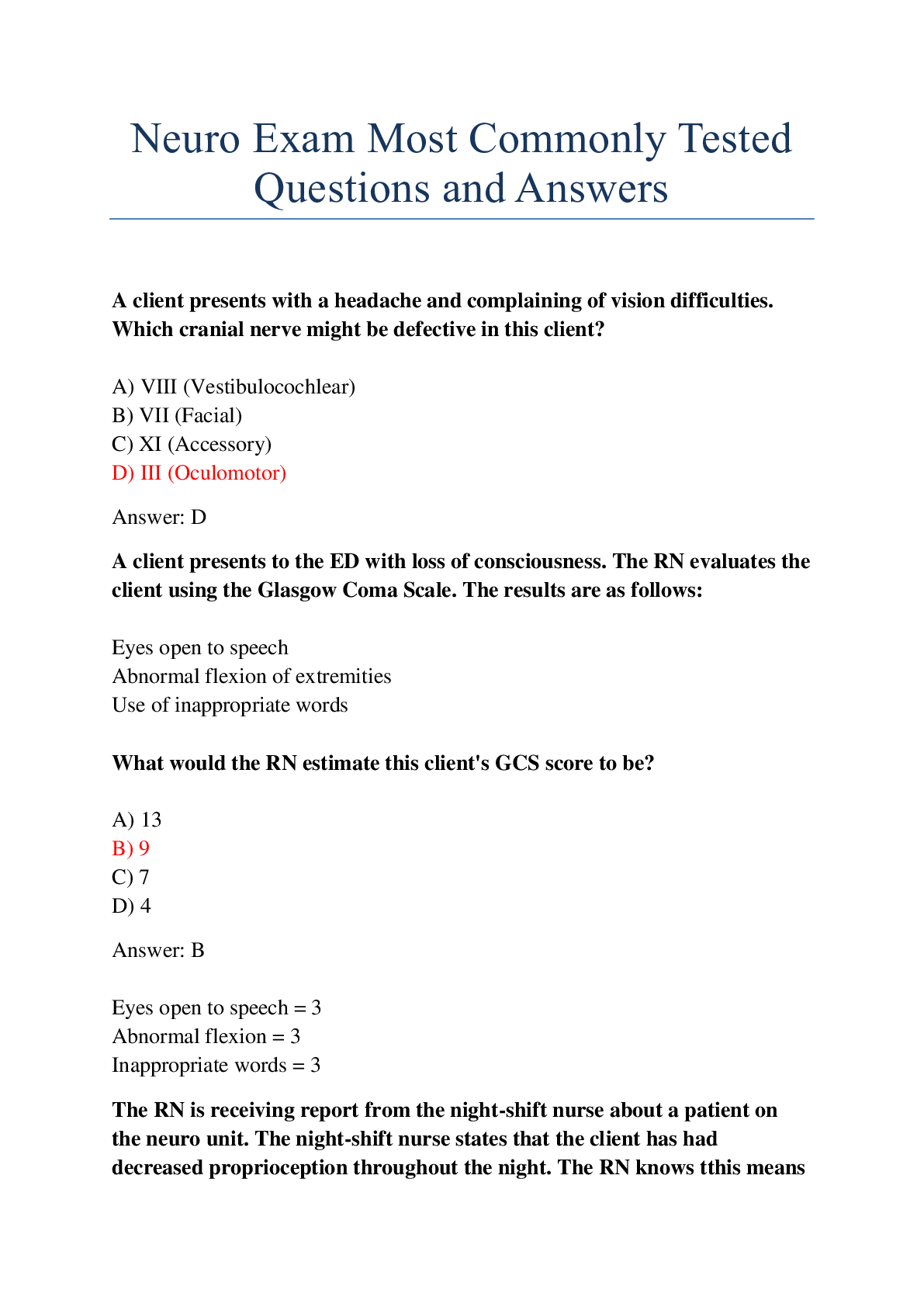
Reviews( 0 )
Document information
Connected school, study & course
About the document
Uploaded On
Oct 30, 2020
Number of pages
21
Written in
Additional information
This document has been written for:
Uploaded
Oct 30, 2020
Downloads
0
Views
84

